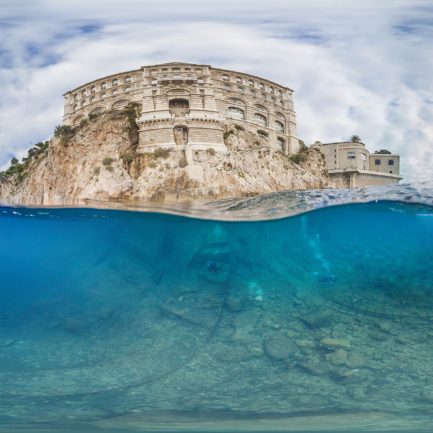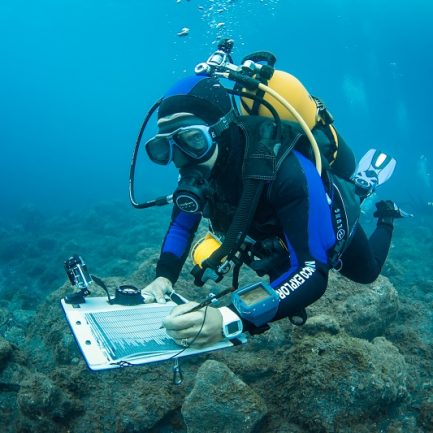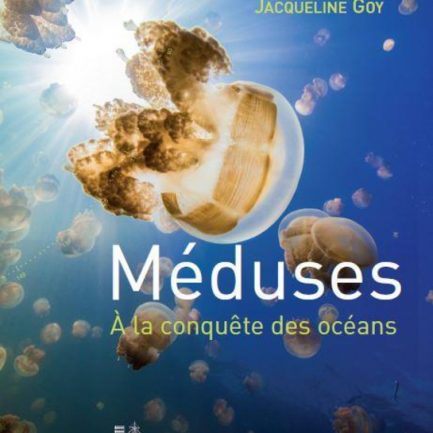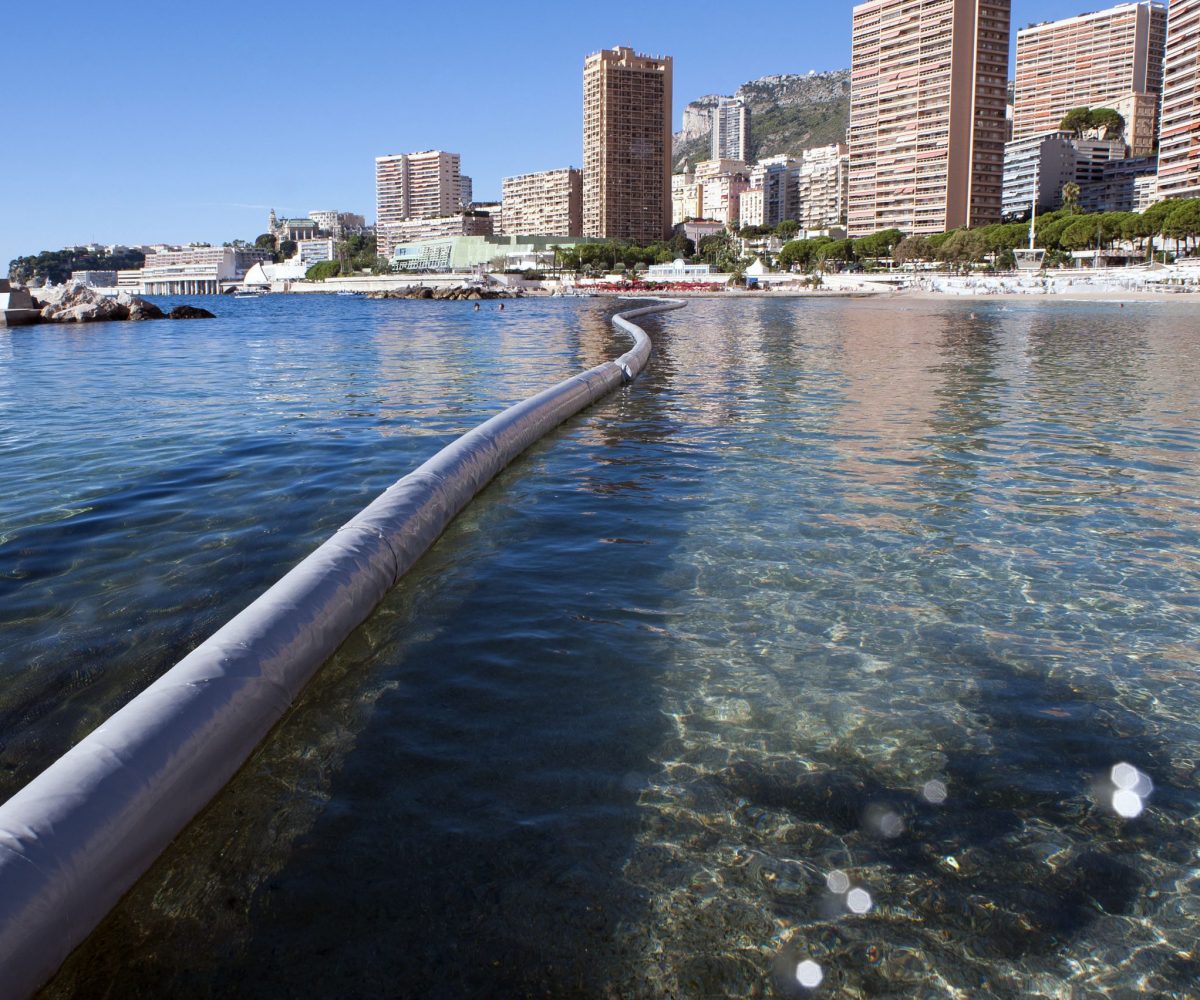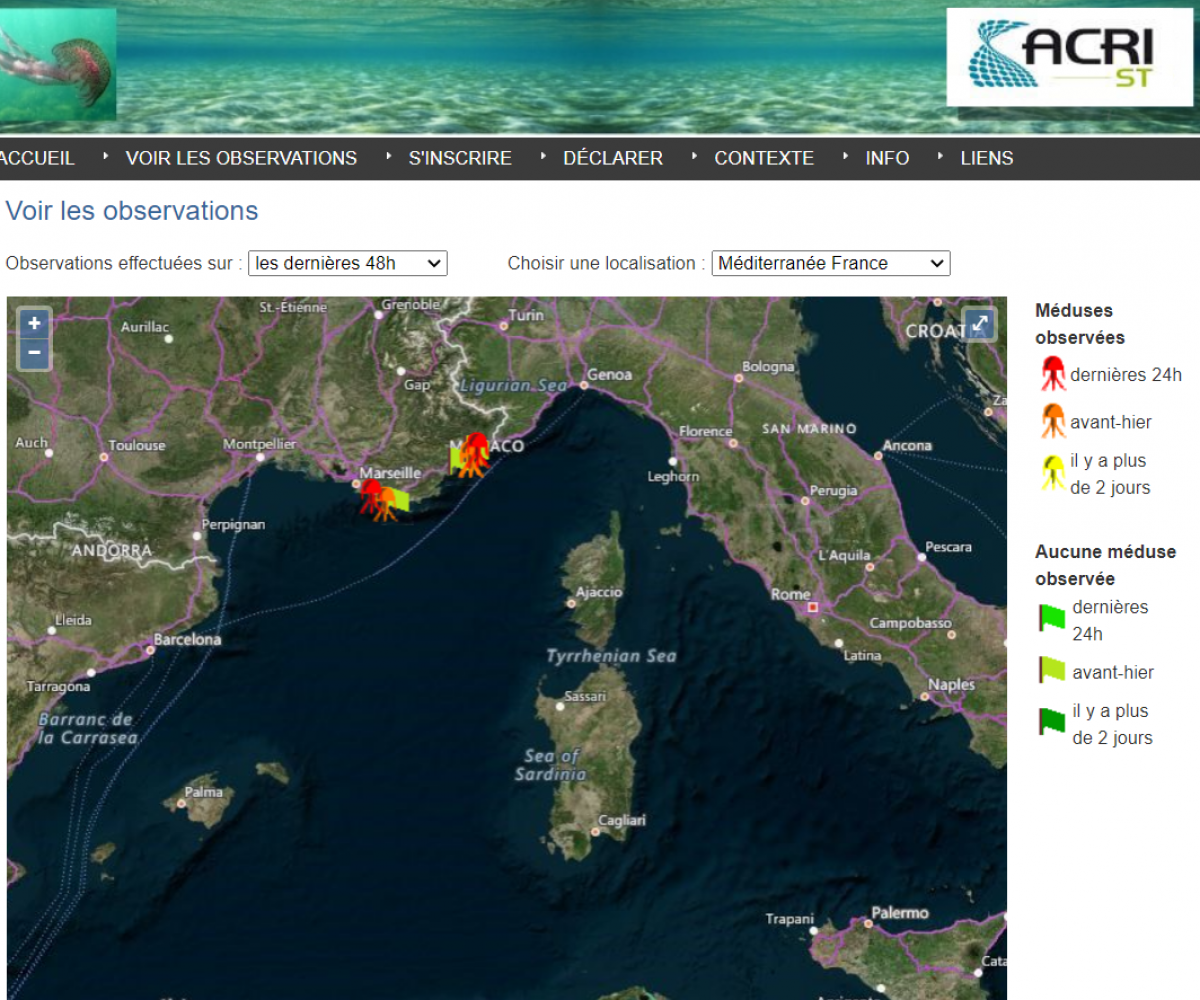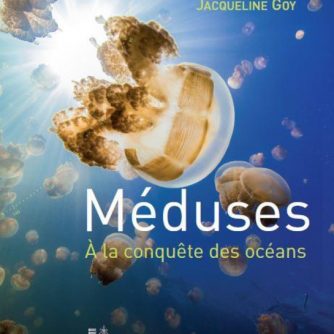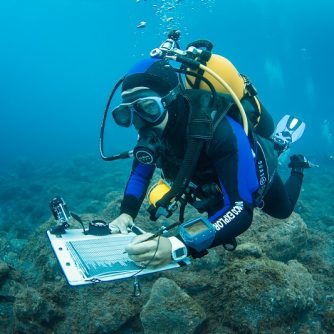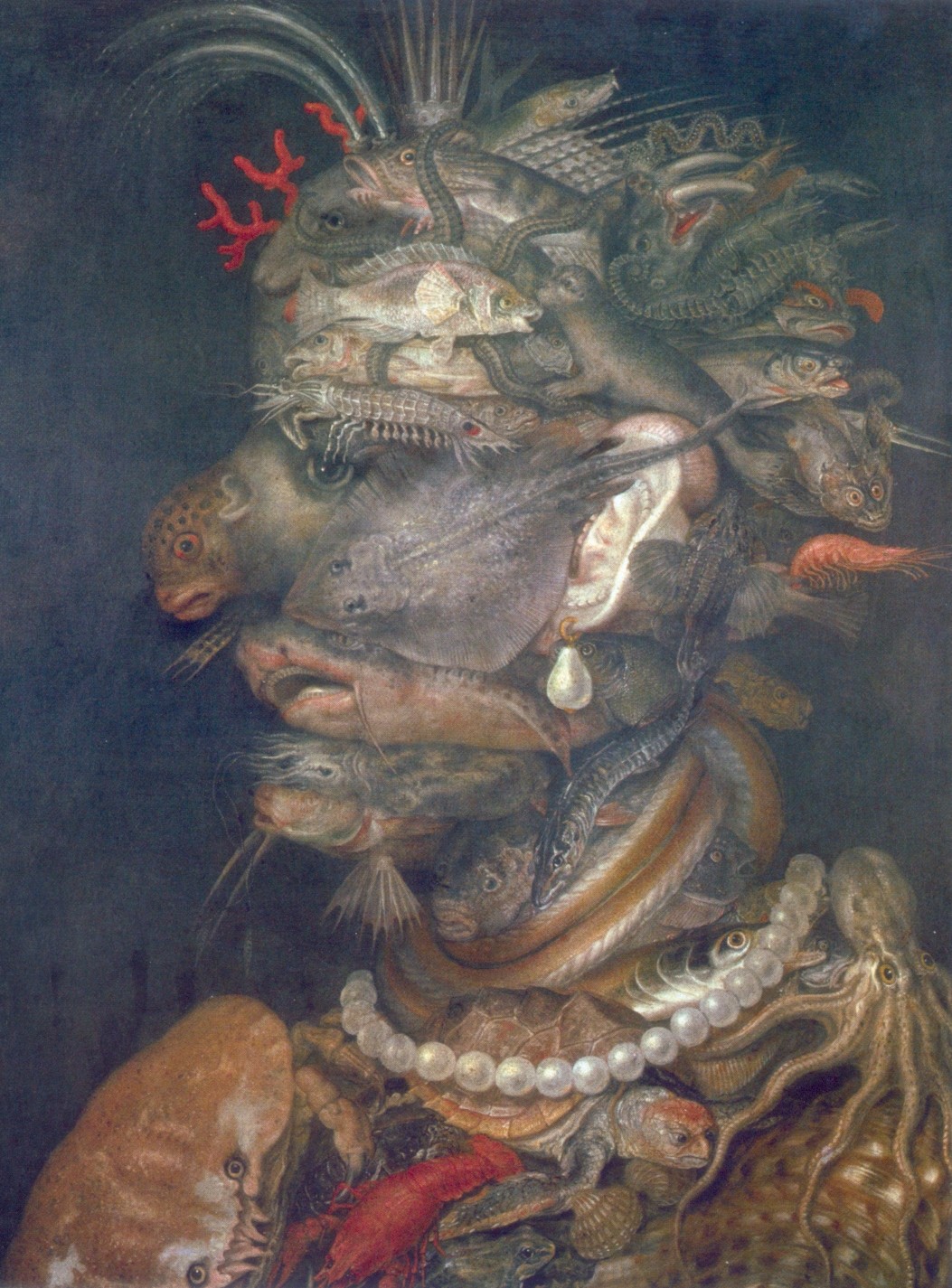THE SHARKS
Threatening or threatened?
Sharks: from myth to reality
The mention of the animal is still frightening and very unpopular. A person who is ruthless in business is often referred to as a “shark”! However, beyond the mythical image of the shark, the reality is quite different.
Overcome your prejudices about sharks !
In 2013, the Oceanographic Institute’s ” Sharks, Beyond the Misunderstanding”program aimed to change the way people look at sharks. Conferences at the Maison des océans in Paris gave the public the opportunity to talk with leading specialists and shark lovers who came to talk about their exceptional experience of living close to these great predators.
The book ” Sharks, beyond the misunderstanding ” takes stock of these super predators with a terrible reputation.
The ecology of sharks: remarkably adaptable
A fin suddenly breaks the surface before diving as a bather approaches… This is a sight that is enough to empty the most crowded beach in a few seconds. A representation engraved in our imagination, which crystallizes all our fears.
Always on the lookout for prey that will have little chance of escaping their vigilance, outrunning them or resisting their impressive jaws, sharks have the reputation of being the most ferocious of marine animals, and man’s “best enemy”.
The image of the super-predator has haunted us for centuries. The cinema as well as the media are there to terrorize even the most marine among us. The reality is not so caricatured. These fish, much less dangerous than we think, are no less fascinating.
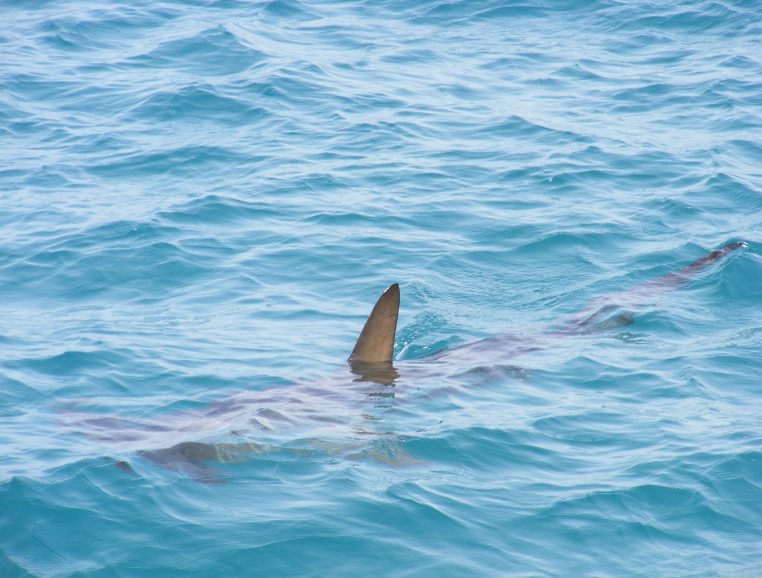
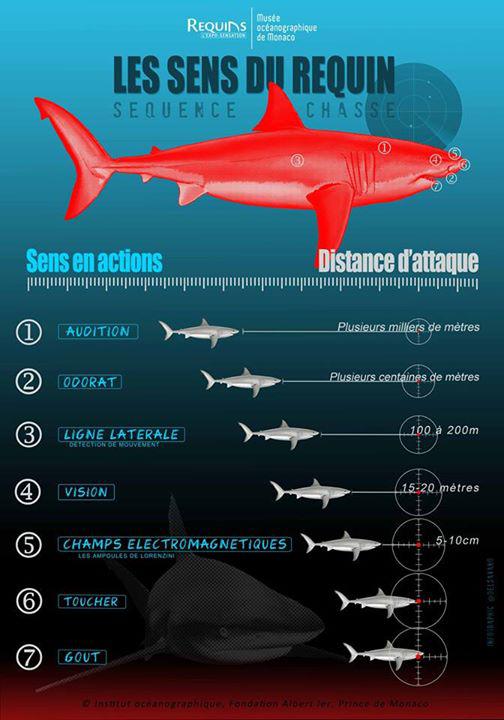
Shark attacks: leaving your preconceptions behind
To detect prey, the shark is equipped with a number of organs and sensory sensors that allow it to orient itself and move, making it an efficient predator.
It is not one sense in particular that gives the shark the advantage, but rather the complementarity and synergy between them all. Depending on the environmental conditions, they will be useful at different times.
The sense of smell is effective over a few tens of kilometres, to detect prey at a distance; vision allows the preparation of an attack over a few tens of metres, and the detection of electric fields allows the exploration of the surroundings within a radius of two metres.
The super powers of sharks
Do sharks have ears?
Do sharks have good eyesight?
Sharks do not have ears as such, but pores on the top of the head.
In the absence of an eardrum, the whole body acts as a receiver of sound vibrations which are then transmitted to the inner ear.
The latter is particularly powerful and governs not only hearing but also balance and orientation.
Sharks are sensitive to low, or even very low, frequencies, which propagate best in an aqueous environment.
Often hampered by the turbidity of the water, sight is perhaps the sense least used by sharks in searching for and detecting prey.
In general, it is the contrasts that they distinguish particularly by twilight vision.
The glow that can be seen in the eyes of the great white at dusk or in semi-darkness is due to the presence of a kind of reflector, the tapetum lucidum (Latin for “shiny carpet”) which improves vision in low light.
The sense of smell, a very powerful sense
The ampoules of Lorenzini
The sharks smell “in stereo” and detect where the smell is coming from, and trace it back to its source for about ten kilometres. They are sensitive to dilutions, for blood, of the order of one centilitre (the value of a thimble) diluted in 100,000 litres of water.
These are tiny pores scattered around the eyes and mouth, which detect the weak electrical currents produced by living things (even those buried in the sand), as well as variations in water temperature and salinity.
The sensation of touch in sharks
The lateral system, a specific sensor
The highly developed sense of touch is similar to a kind of “skin taste” made possible by the presence of sensory crypts all over the body. These receptors, distributed throughout the body, allow the shark to appreciate the environment in which it is moving.
A simple touch is enough to tell the shark if the prey it is considering is suitable. That’s why he sometimes just shoves without biting.
The strength of the animal and the roughness of the skin make this contact dangerous.
But it also has a “real” taste, via the taste buds, also called “barrel organs”, which line its oral cavity
Sharks do not perceive their prey by smell alone.
Like other fish, they have thousands of pores along a line from head to tail that are sensors for pressure and mechanical vibrations.
The presence of these organs explains why sharks react so immediately to sounds produced in the water by blows or colliding objects.
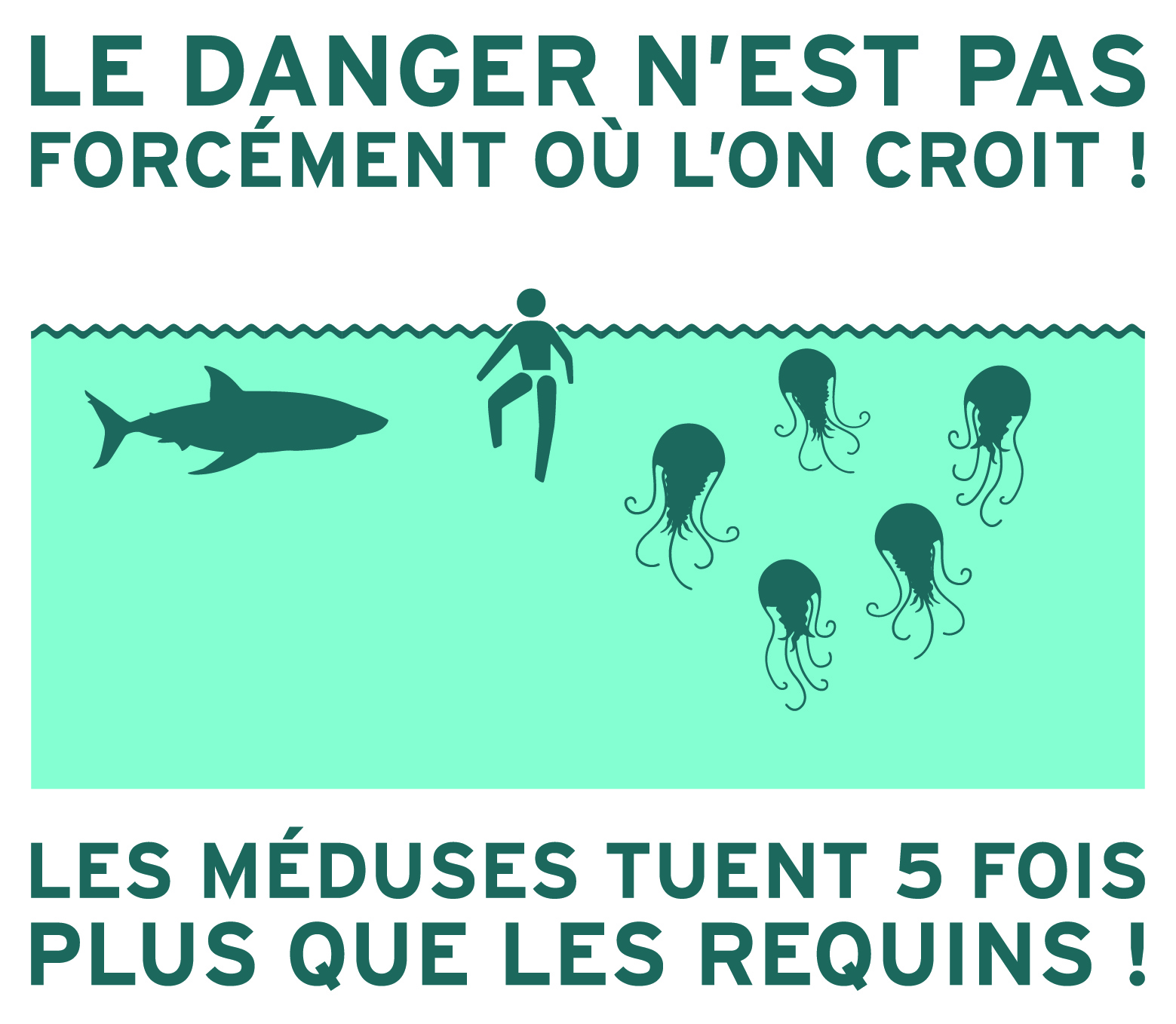
Are all shark attacks fatal?
It is not known why sharks sometimes attack humans. A misunderstanding or a defensive reaction is often cited. It is also possible that the shark may see humans as potential prey, even if they are not part of its usual diet.
Given the size and strength of a human being and a shark, a bite, even if it is the result of a mistake, can be serious and even fatal for the victim.
The few dozen attacks that occur each year around the world do not always result in death. In terms of dangerous animals, mosquitoes are the most dangerous serial killers. Even dogs, which are domestic animals very close to humans, kill more than sharks.
Attacks under high surveillance
The first global shark attack file, theInternational Shark Attack File (ISAF), was created in the United States in 1958.
Developed by a group of scientists at the request of the U.S. Navy, its objective was to investigate the respective roles of environmental factors and victim characteristics in triggering attacks.
The impact of shark accidents on the tourism industry has led to the creation of new research structures and databases: the Australian Shark Attack File in Australia and the Natal Sharks Board in South Africa, which now make it easier to compare shark attack figures.
In 2013 and 2014, under the impetus and chairmanship of H.S.H. Prince Albert II of Monaco, the Oceanographic Institute organised two international expert workshops on sharks to create a ” Shark Risk Toolkit “. Its objective: to bring together existing solutions around the world to protect against shark attacks, while putting into perspective the reality of the risks incurred by humans.
Protecting and conserving sharks: a worldwide emergency
Sharks are victims of fishing and bad practices. The industrialization of fishing and man’s voracious appetite for shark products mean that 50 to 150 million of these animals are killed each year by man.
The late sexual maturity of sharks and the low number of offspring are limiting factors in the renewal of their populations, and today shark populations are clearly threatened.
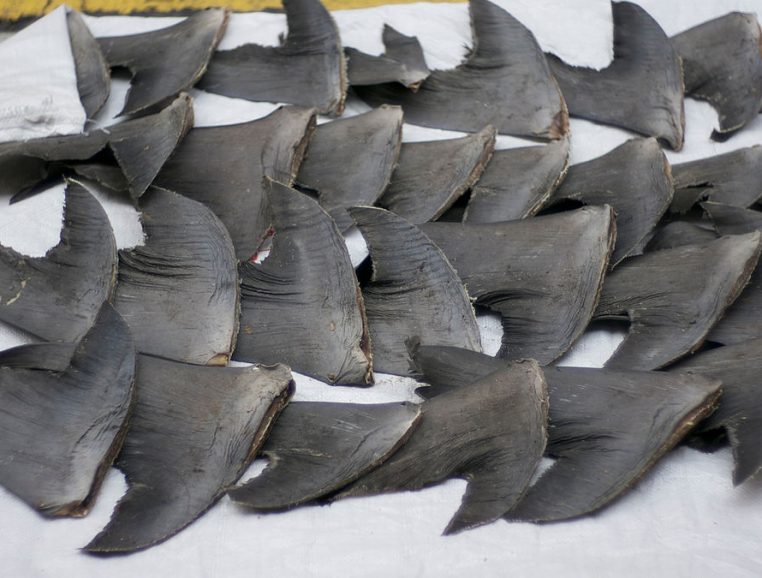
The horror soup
More than two-thirds of sharks are harvested solely for their fins. To satisfy the growing demand, some fishermen have found an extremely profitable solution, which consists in cutting off the fins on the spot and throwing back into the sea an animal that is condemned to death anyway. This is called “finning”.
Of the 100 million sharks killed each year, 73 million are killed for soup. Some countries prohibit this practice at sea and force fishermen to bring whole sharks back to port, in an attempt to limit the slaughter and not waste this resource.
Shark fin soup is a popular traditional Chinese dish with supposedly aphrodisiac properties. Long reserved for celebratory meals in Hong Kong, where 89% of the population serves it at wedding feasts, it became available to millions of people in the 1990s, following the Asian economic boom.
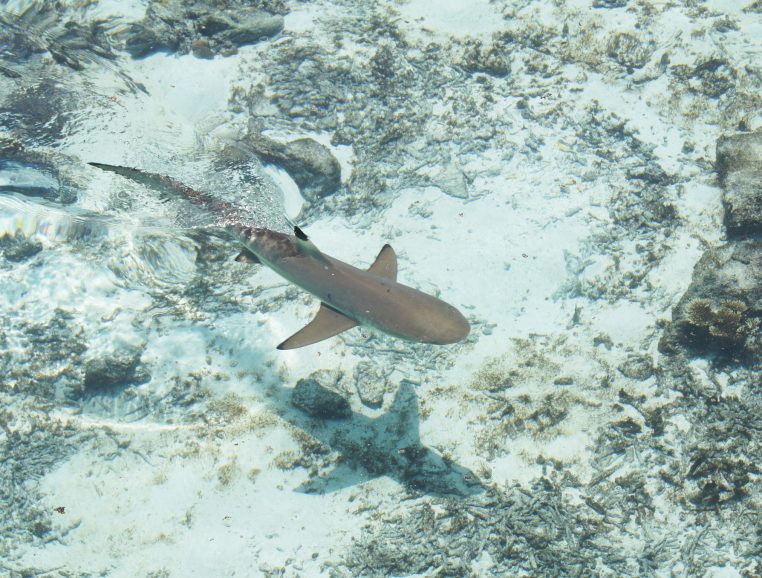
Sharks, essential to the balance of the oceans
Sharks are the keystone of marine ecosystems, ensuring their balance and resilience.
If sharks were to become extinct or scarce, ecosystems would be disrupted and many other species would be threatened by a “cascade effect”.
When a predator disappears, its usual prey grows rapidly and in turn increases the pressure on its prey.
The entire ecosystem is disrupted by the disappearance or depletion of top predators, including the various species of commercial interest.
The fishing industry may therefore suffer from a cull that it caused.
Shark and carbon storage
It has recently been recognized that cetaceans and large pelagic fish such as sharks and tuna play an important role in the climate change issue because of the biomass they represent.
Containing 10 to 15% carbon in their flesh, they sequester a lot of carbon in the ocean. When they die by natural mortality, old age or are eaten by predators, the carbon they contain is recycled into living matter or buried at the bottom of the ocean, sequestered for thousands, even millions of years.
However, when they are fished and extracted from the ocean, the carbon is then put into circulation on the surface of the planet and ends up as CO2, contributing to the greenhouse effect. To this must be added the large quantities of CO2 released by the fishing activities themselves, which are carried out in ever more remote locations.
To combat climate change, some experts advocate restoring fisheries and apex predators, i.e. stop fishing them and just leave them in the water.
Shark protection and conservation: a global emergency
In the past, it was considered that a good shark was a dead shark!
Recent research has highlighted the ecological role of sharks in marine ecosystems.
As predators at the top of the food chain, sharks regulate the prey populations on which they feed.
Overexploitation of these top predators has cascading effects in the food chain that are detrimental to the ecosystem and to fisheries, as it can lead to an outbreak of species undesirable to humans.
Because of their regulatory role, sharks are increasingly being incorporated into fisheries management plans.
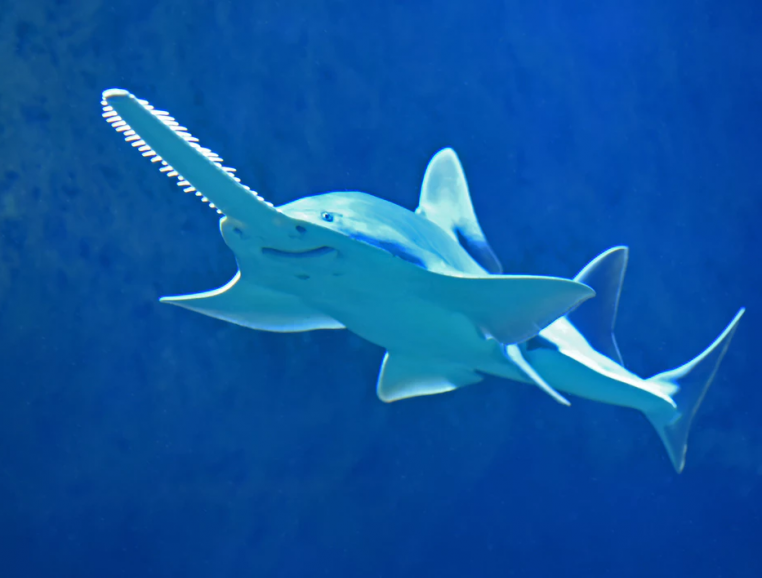
See also
The “toolbox” for defending against shark attacks
At the initiative and under the leadership of HSH Prince Albert II of Monaco, and thanks to impassioned discussions between international experts, a “toolbox for handling shark risks” was created. Its aim is to gather together all existing solutions from around the world for preventing shark attacks, while highlighting the actual risks undergone by people.
A document drafted during a meeting organised by the Oceanographic Institute
In 2013 and 2014, the Oceanographic Institute organised two workshops for international experts on sharks. In the wake of the second workshop, significant research work was carried out and produced this single document, the “toolbox for handling shark risks”.
This document, which overcomes the obstacle of conflict between man and animal, draws up a wide-ranging view of existing solutions and those in development to tackle the risk of shark attacks.
Instead of exterminating every shark in the ocean, this “toolbox” shows that an organised and peaceful cohabitation with sharks is now possible.
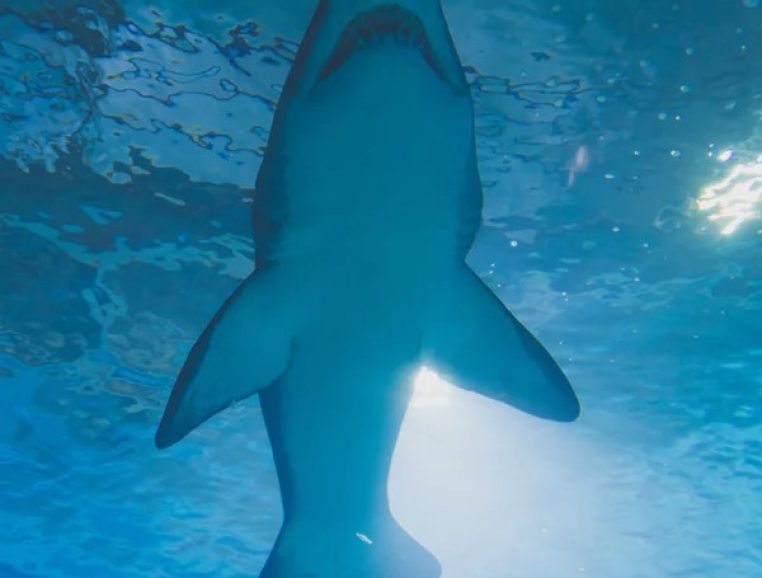
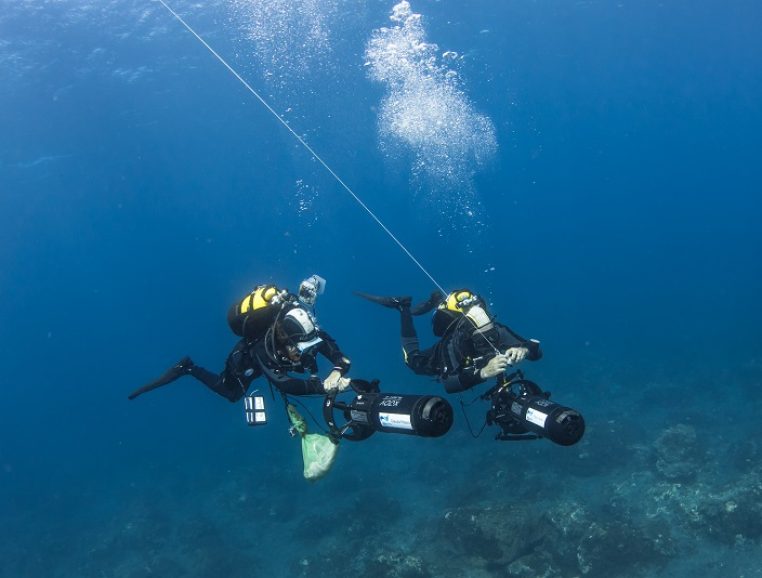
Very low risk of fatal attacks
The risk of a fatal shark attack is extremely low at a worldwide level: there are only around ten such attacks per year.
This pales in comparison with the risks associated with sports or with other animals such as mosquitos, which kill over 800,000 people every year.
Only five of the almost 500 species of shark represent a danger to humans, owing to their large size and their diet. Most accidents are caused by great white sharks, bulldog sharks and tiger sharks, which frequently swim near the coastline.
In spite of the low number of accidents, each attack is heavily mediatised, which damages the reputation of sharks.
11 sheets on concrete solutions
There are solutions to the risks posed by sharks. The 11 sheets in this dossier set out a number of initiatives from locations around the world that are known for shark attacks on people. Information, shark forecasts, search and alert, shark watch, shark spotters, separation net, individual repellant, drones and artificial intelligence, detection buoys, anti-shark barriers and radiating cables are the 11 solutions discussed in the “shark toolbox”.
There is no one solution that can be transposed everywhere and whichever system is adopted must be suitable for the local circumstances, as determined by the geography, the species present and their habits, as well as the social context.

En choisissant de consacrer aux seigneurs des mers une grande exposition, et plus largement un cycle de conférences, des colloques et un ouvrage de vulgarisation, l’Institut océanographique souhaite inviter le public à dépasser des stéréotypes bien ancrés, pour partir à la rencontre de ces super-prédateurs, bien plus menacés que menaçants"
Robert Calcagno, directeur de l'Institut océanographique
Allowing a successful cohabitation between people and sharks
There are thus innovative solutions available today to meet the risk of sharks without exterminating them from the ocean. It must be remembered that these animals are essential for the good health of the oceans.
See also
getting involved as a...
responsible eater
Add your title text here
A third of the world’s oceans are being overfished, and fish consumption has never been higher: we are reaching the limits of the protein resources in the sea, despite these resources being essential for millions of people around the world. However, sustainable and well-reasoned fishing is possible, and would leave enough fish left in the ocean, respect marine habitats and allow people who rely on fishing to make their living from it.
FISHING AROUND THE WORLD
FISH STOCKS ARE OVERFISHED AROUND THE WORLD
FISH STOCKS ARE FULLY FISHED AROUND THE WORLD
FISH STOCKS ARE UNDERFISHED AROUND THE WORLD
Source: FAO
It is easier than ever to consume sustainably by varying which species you eat, avoiding rare or threatened species and buying from fisheries that care about the future of the sea.
You should also purchase produce caught locally where possible, as this not only preserves the planet but also supports local fishermen.You can find more information in the user guide from the MSC (Marine Stewardship Council) label as well as from Mr Goodfish, an initiative supported by the Prince Albert II Foundation.
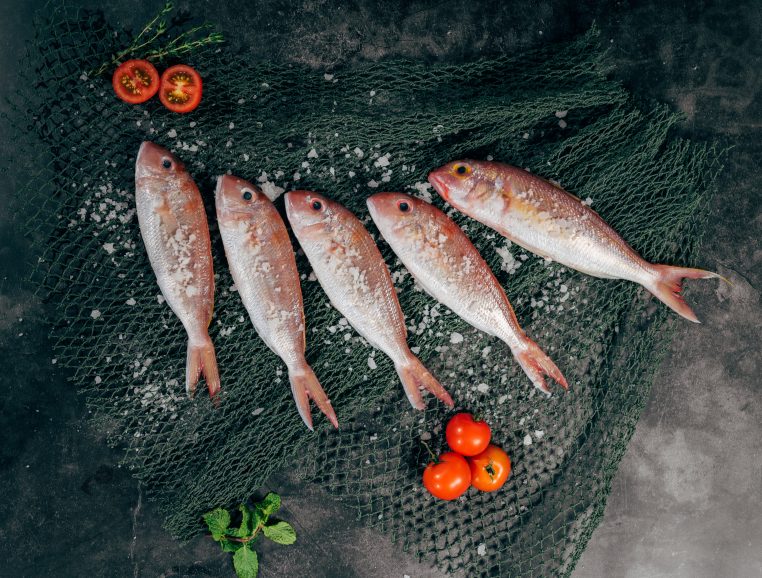
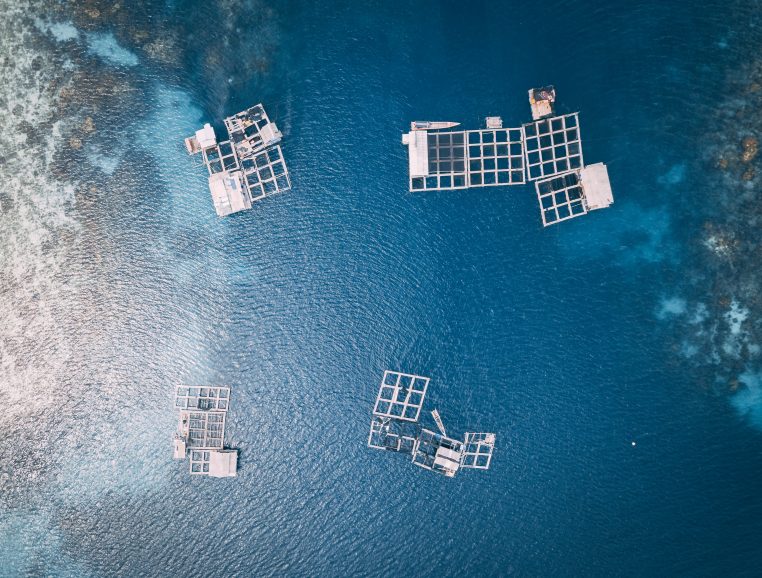
Aquaculture represents the source of around half the fish we eat (sure? I would have said a third…). This is why the ASC (Aquaculture Stewardship Council) label was created in 2010, for fish farmed sustainably. This label has been awarded to 9 species of fish farmed via aquaculture, including salmon, tilapia, trout, pangasius and prawns, as well as marine algae. It also guarantees that the fish was farmed in an environmentally friendly manner and under good working conditions. These labels mean that everyone – distributors, fishermen and consumers alike – can act at their own level.
EXTERNAL RESOURCES
See associated videos
See also
Coral reefs: solutions for now and for tomorrow
Save the coral reefs
On the occasion of the 3rd International Year of Coral Reefs (IYOR2018), the Oceanographic Institute of Monaco co-organised a symposium at the Maison des Océans in Paris. The workshop focused on the latest knowledge and research on these environments and on solutions to try to halt their decline.
This symposium, which took place on 20 June 2018, was organised by the Foundation for Research on Biodiversity (FRB), the Oceanographic Institute of Monaco, CRIOBE, the Platform Ocean and Climate (POC) and the French Initiative for Coral Reefs (IFRECOR).
Status report, pressures and threats
Its preliminary objective was to take stock of the services provided by corals and their ecosystems, their state of health and the threats they face. It then continued with two round tables bringing together scientists, managers and civil society actors around two major themes. On the one hand, how to mobilize and adapt governance to implement new tools for better protection of spaces and species. On the other hand, to exchange on the latest scientific knowledge concerning the functioning of coral reefs and innovative management solutions to develop them on a larger scale.
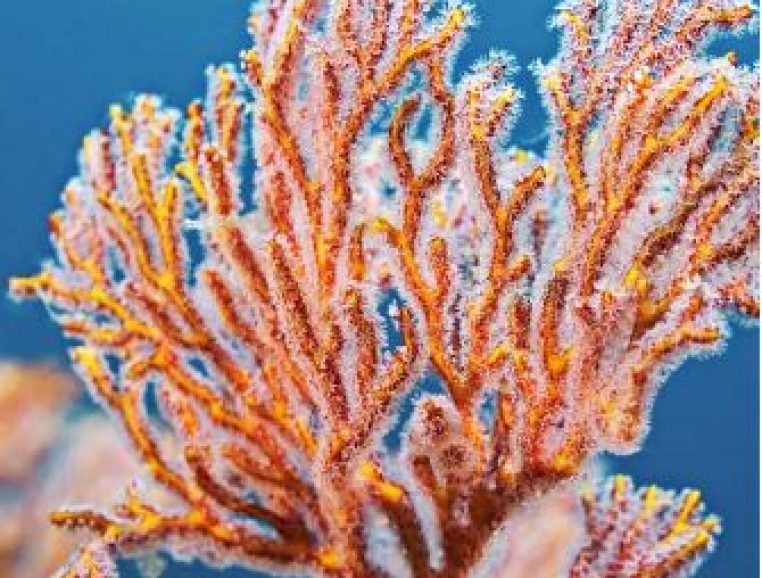
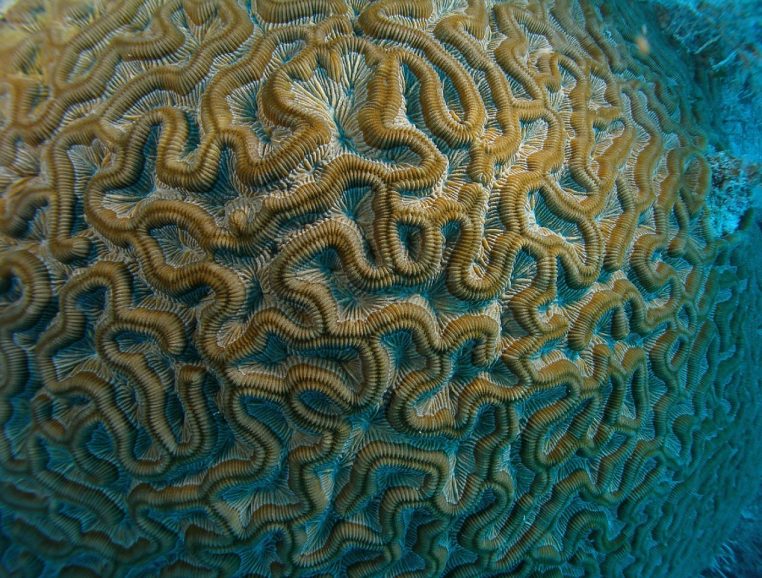
Everybody’s business?
New tools are needed to better protect areas and species and to limit anthropic pressures. Effective reef protection cannot be achieved through a unilateral approach and should involve as many stakeholders and sectors as possible in protection and governance choices. What perceptions do local communities have of the services provided by coral reefs? The place they occupy in their daily lives? On this basis, how can they be mobilized and involved more widely in decision-making? What financial tools should be developed to guarantee the viability and sustainability of conservation and protection policies?
Organising the fight
The pressures and threats to coral reefs are such that their continued existence on the planet is at stake. Nevertheless, there is still time to act. Scientific advances have revealed hitherto unknown adaptation mechanisms in certain coral strains, and various stakeholders are seizing on these results and mobilizing to ensure the sustainability of reefs.
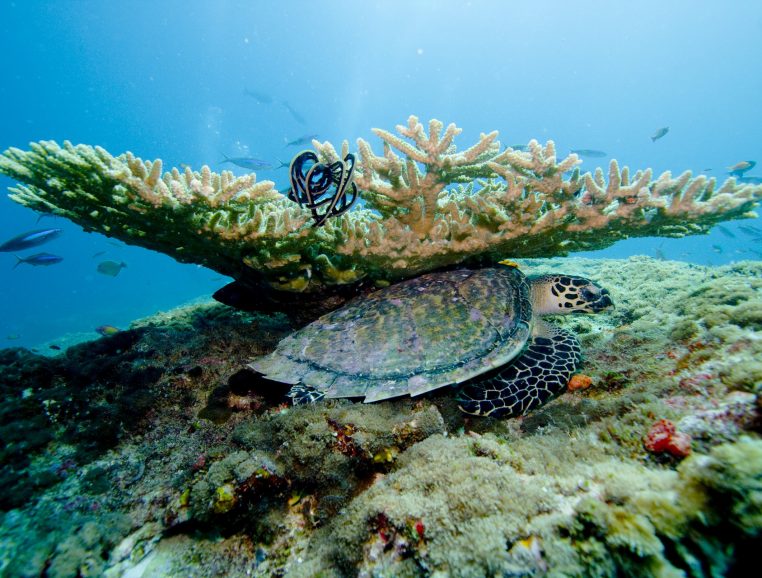
See also
Jellyfish, the new kings of the ocean
The gelling of the oceans, myth or reality?
Increasingly numerous in the world’s oceans, jellyfish, an animal that is both fragile and fearsome, could take over from fish and seriously threaten the already damaged marine balance. Robert Calcagno, Director General of the Oceanographic Institute, and Jacqueline Goy, Scientific Attaché at the Oceanographic Institute, decipher this disturbing phenomenon during a lecture given on 14 May 2014 at the Maison des océans in Paris. Nassera Zaïd reports on the event.
What do we really know about jellyfish?
Often associated with the pain of their stings, jellyfish are “gelatinous organisms that have always fascinated the public and scientists,” introduces Robert Calcagno. Nearly 1,000 species have been identified, including the Pelagia noctiluca, which is very common in the Mediterranean.
Jellyfish come in a variety of shapes and sizes ranging from a few millimetres to over two metres in diameter. 98% of their body is made up of water, formed by a bulging part (the umbrella), where the mouth and the reproductive organs (or gonads) are located, which can be observed through transparency.
All around, a series of tentacles with stinging cells are used to harpoon prey. Their sting is paralyzing, even deadly as for the jellyfish Chironex fleckeri which lives along the Australian coast.
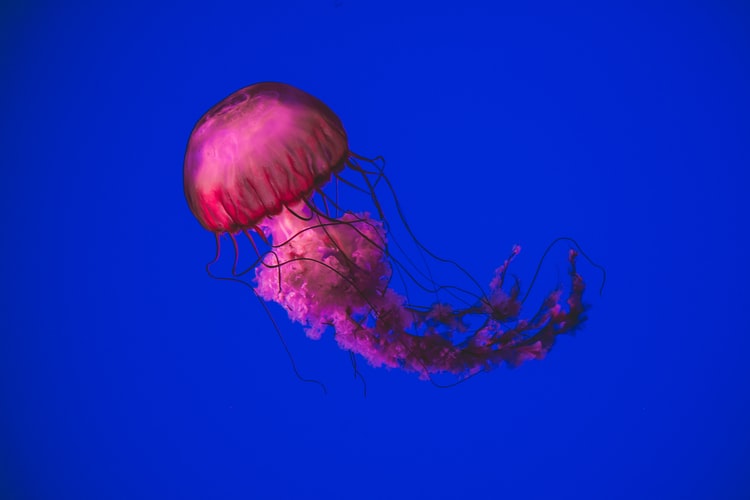
Jellyfish, a predatory instinct?
“Jellyfish are constantly eating to reproduce,” explains Jacqueline Goy, who has been studying cnidarians for thirty years.
Fertilized in the water, each egg produces a larva, the planula, which will settle on the bottom and develop a polyp which will itself multiply by budding to give rise to a colony of jellyfish.
Hunting is a necessity, hence its predatory instinct. Despite this, “jellyfish are very fragile animals. It is an animal that is not protected. They don’t have a shell like mollusks, nor do they have a test like sea urchins. A particular morphology which makes one think of “a drop of water in the sea, moving with the currents”, describes the specialist.
However, this physical vulnerability does not rule out the danger feared by scientists: its mass reproduction.
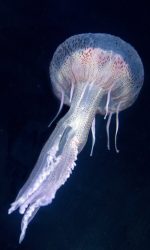
Chronicle of an invasion announced?
“Jellyfish are currently overtaking all other marine organisms and becoming dominant in the seas,” says Jacqueline Goy.
A growing proliferation which for several years has taken on the appearance of uncontrollable colonization.
Previously, there were pullulation cycles every twelve years,” explains Robert Calcagno. We even used to talk about ‘jellyfish years’. But since the 1980s, and especially since the 2000s, all years are jellyfish years. We could even say: there are no more years without jellyfish.
The main reason for this change is the impact of human activities on the oceans. First and foremost, overfishing. “By catching tons of fish (80 million are caught each year), trawlers eradicate a number of predators for jellyfish, such as tuna, turtles, sunfish … They also eliminate their competitors, small fish, anchovies or sardines that feed on the same zooplankton.”
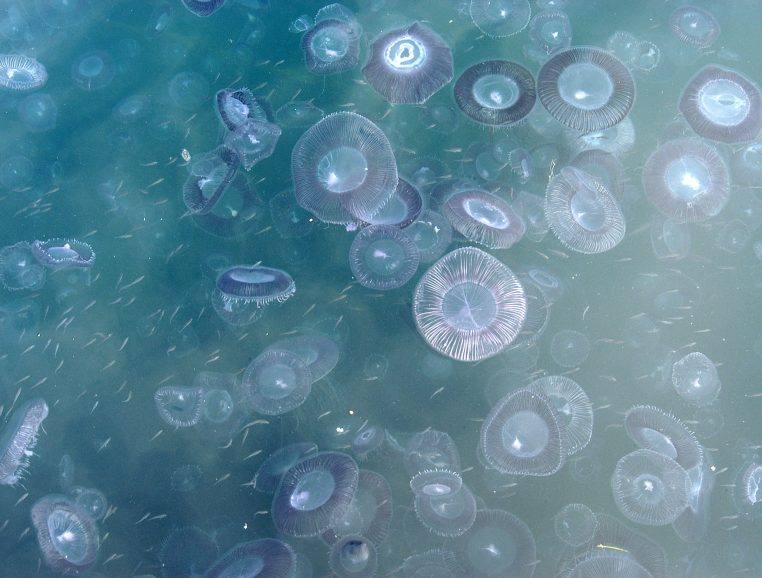
Are human activities the cause of this outbreak?
“Jellyfish are currently overtaking all other marine organisms and becoming dominant in the seas,” says Jacqueline Goy.
A growing proliferation which for several years has taken on the appearance of uncontrollable colonization.
Previously, there were pullulation cycles every twelve years,” explains Robert Calcagno. We even used to talk about ‘jellyfish years’. But since the 1980s, and especially since the 2000s, all years are jellyfish years. We could even say: there are no more years without jellyfish.
The main reason for this change is the impact of human activities on the oceans. First and foremost, overfishing. “By catching tons of fish (80 million are caught each year), trawlers eradicate a number of predators for jellyfish, such as tuna, turtles, sunfish … They also eliminate their competitors, small fish, anchovies or sardines that feed on the same zooplankton.”
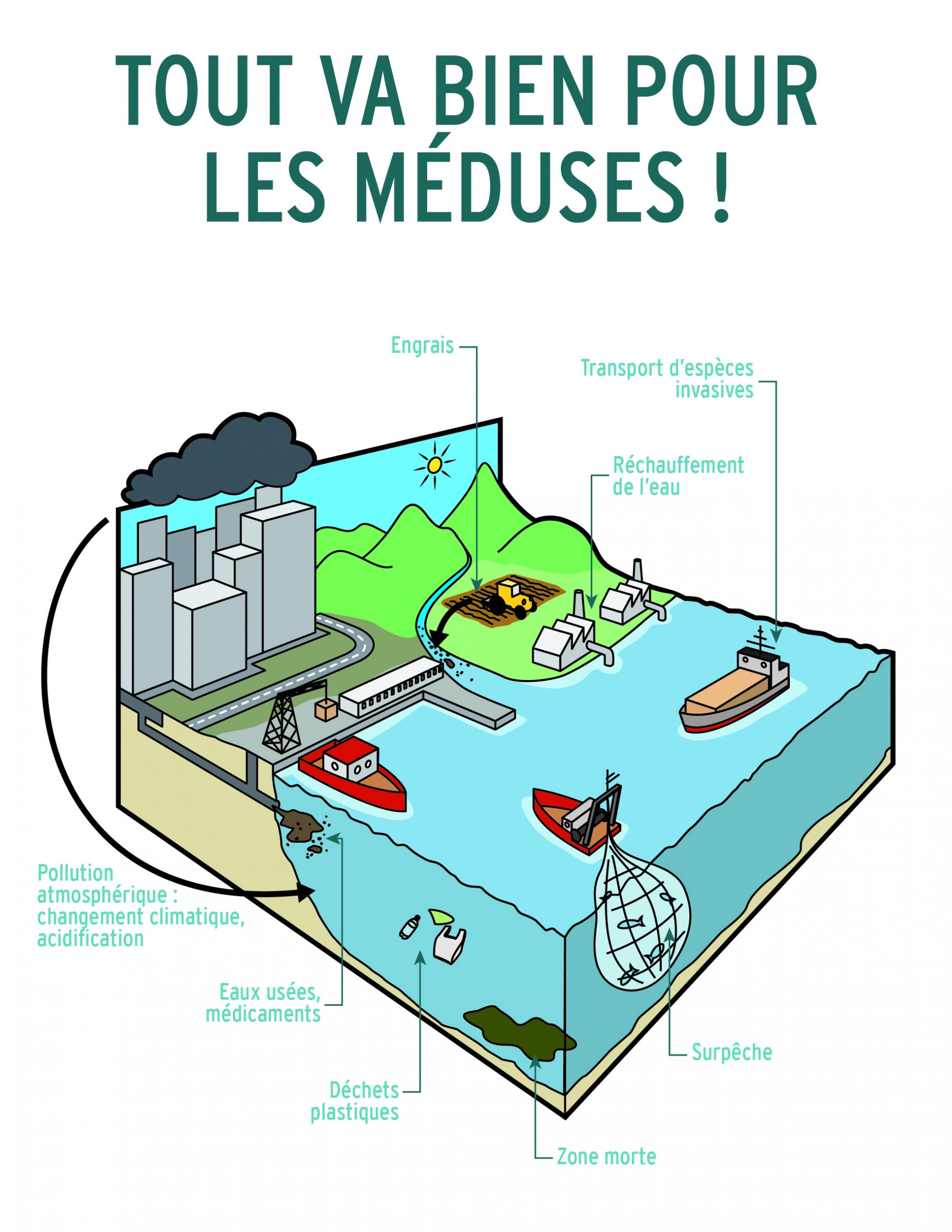
Irreversible damage to the oceans?
Jellyfish are ultimately formidable,” concludes Robert Calcagno. To understand this, you just have to look at the statistics and see that, each year, more than fifty people die as a result of jellyfish stings, compared to ten for shark attacks. But nobody talks about it that much.” And their impact is not limited to burns. Another victim of the jellyfish is the economy.
“The outbreaks have already put boats in trouble, as happened, says Robert Calcagno, to a Japanese trawler that capsized on a perfectly calm sea because of the weight of the jellyfish clusters caught in its net.
Aquaculture companies are also victims of these cnidarian clusters that come to feed on the fry and thus wipe out the farms. Namibia, once renowned for its quality fishing, has seen its fish stocks disappear due to overfishing for jellyfish. So what solutions are available to us?

What can be done about the jellyfish invasion?
Several inventions have been created, even the most improbable ones, such as the “jellyfish destroying robot” which, once immersed in water, detects and crushes the animals with a propeller. “The remedy is however worse than the evil,” Jacqueline Goy is astonished, “since by cutting them in this way, the reproductive cells are released and multiply”.
Another solution that has been tested is a protective net for the beaches. However, its high cost makes it difficult to generalize on our coasts.
Prevention by modelling to alert the public of the advance of jellyfish, organised by the Oceanological Observatory of Villefranche-sur-Mer in the form of Météo-méduses, may just help to better protect oneself.
Last option: eat them. However, it should be noted that only a dozen species out of 1,000 are edible,” says Jacqueline Goy. The high water content of jellyfish does not make it a very nutritious food.
Once the jellyfish have settled in, it’s already too late,” says Robert Calcagno. We need to restore the balance of the oceans, like 50 years ago.” How? By controlling and promoting sustainable fishing, by developing clean maritime transport and purification stations, and by recycling the hot water rejected by nuclear power stations to heat greenhouses, for example.
Jellyfish Programme: the Institute of Oceanography's lectures
Jellyfish, the new lords of the sea
Robert Calcagno and Jacqueline Goy
14 May 2014 - House of Oceans Paris
Medazur: Jellyfish weather in the Mediterranean
Gabriel Gorsky
11 June 2014 - House of Oceans - Paris
See also
TITLE
Jellyfish as seen through Natural History
Proliferating today in our oceans because of human activities, jellyfish have survived through the ages. Known and described since Aristotle, they were mainly named in the 19th century by the naturalist François Péron. Jacqueline Goy retraces their history through history.
What is the connection between Aristotle, Pliny the Elder and jellyfish?
In antiquity, Aristotle was interested in them and among the hundred or so marine animals he described, he called them cnidae, which means “stinging”, specifying that they move here and there on the water. In homage to Aristotle, naturalists of the 20th century created the phylum of cnidarians to classify jellyfish, corals, sea anemones… which all sting. Four centuries later, Pliny the Elder observed the movements of jellyfish, which reminded him of the contractions and dilations of breathing, and he named them Pulmo marina, the marine lung.
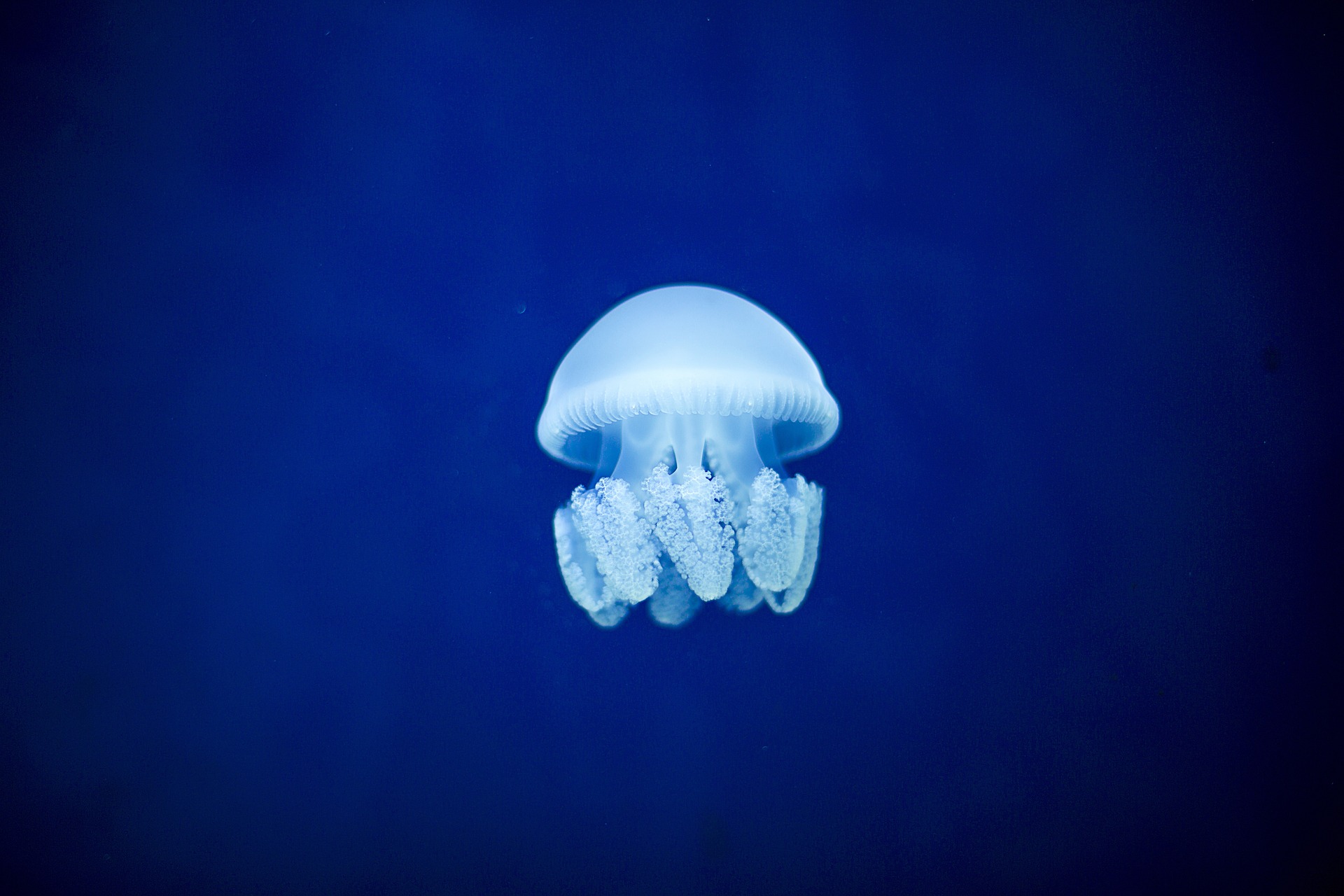
The fifth species of nettle
In the Middle Ages, the marine bestiary was mainly populated by monsters, chimeras and mermaids, especially since this period was more interested in theology than in the study of nature.
It was not until Guillaume Rondelet and his work Histoire entière des poissons published in 1554, in which he described a series of stinging animals called “sea nettles”. The fifth species is the jellyfish Rhizostoma pulmo, which has a fabulous fate, arranged in a crown, in the painting TheAllegory of Water by Giuseppe Arcimboldo in 1566.
The great turning point in the knowledge of zoology is obviously Carl Linnaeus. He proposed a classification of the living world, both plant and animal, in his Systema naturae, a seminal text, and in the fourth edition of 1744, he introduced the name medusa by comparison with the face of the Gorgon.
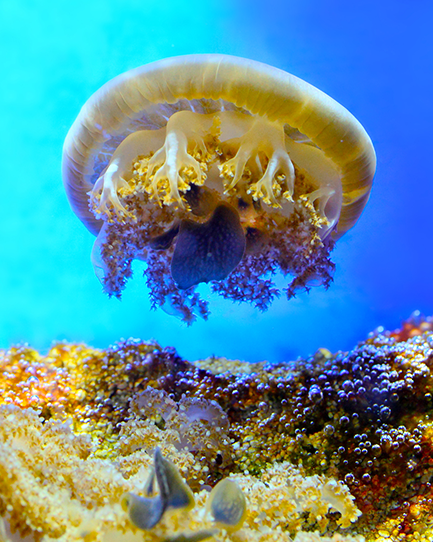
in the 19th century, medusas acquire ancient names
Jean-Baptiste de Lamarck, who was a professor at the National Museum of Natural History when it was founded in 1793, assumed that life originated “in the gelatinous masses scattered in the great ocean”. And the gelatinous masses could well be the jellyfish.
This is why a young naturalist, François Péron, took up the subject to make a monumental study of it. According to Albert Soboul, a historian specializing in the French Revolution, revolutionary fashion introduced a majority of heroes from Antiquity into the first names and it also fell on the jellyfish!
Péron does not hesitate to give the names of gods and goddesses to his species. Thus, there are Cepheas, the Cassiopeaand Persaand Chrysaora, of the Geryonia and others, all dedicated to the characters that revolve around the myth of Medusa, names that are still in force.
See also
Jellyfish: the conquest of the oceans
Jellyfish, conquering the oceans
Jacqueline Goy, an oceanographer-biologist specializing in the study of jellyfish, and Robert Calcagno, director of the Oceanographic Institute of Monaco, co-authored the book “Jellyfish, conquering the oceans” published in 2014. Well-documented and extensively illustrated, this book helps us to learn more about these organisms, which are both feared and fascinating, and to understand how climate change is encouraging their expansion.
Knowledge of jellyfish has fortunately advanced recently, but my concern regarding the exhaustion of the oceans has too. It is a certainty that jellyfish appear to be the only species that prosper throughout the ocean and that benefit from all our excesses. [...] They are clearly showing us a road we do not want to take, but that we are drawn into following by our short-term appetites. Up until now we have associated the sea with freedom and just letting things happen. We have become as complacent with the oceans as we have with our environment in general.
Extrait de la Préface de S.A.S. le Prince Albert II de Monaco
What if the oceans were “gelling"?
Jellyfish are thriving. Graceful and fragile in appearance, they adapt to marine pollution, take advantage of the excesses of fishing and gradually conquer our seas. Is ocean gelling inevitable? How far will the jellyfish go?
Through the book-documentary “Jellyfish: conquering the oceans”, the Oceanographic Institute puts into perspective the degradation of ocean health and the outbreak of jellyfish. A reminder of the risks of reckless overexploitation of the marine environment.
Jellyfish, sentinels, alert us to the quality of the water. This book questions the relationship between man and the sea, the natural environment and the fragile balance that it is vital to preserve.


Do jellyfish have unthought-of powers?
The apparent fragility of these organisms hides a formidable efficiency. Primitive in appearance, they let themselves be carried by the currents and in fact go to the essential: feeding and reproduction. However, their efficiency and robustness are exceptional.
Their life cycle is astonishing, between dormancy and massive reproduction, even rejuvenating when the need arises. Jellyfish hold the key to immortality. They also have an exceptional capacity to adapt. They have adapted to all oceans, including fresh water.
Today, they are resisting our excesses, when we pollute the oceans with our nitrates, our medicines or our plastic waste. After having taken advantage of the boom in maritime transport to conquer new spaces, they are only waiting for climate change to launch their next offensive.
Man and jellyfish: friends or enemies?
Jellyfish can cause even paralysis of our activities. On European beaches, jellyfish are the nightmare of holidaymakers. On the other side of the world, their bites can be deadly. And they also attack fishing, aquaculture and even nuclear power plants, which they choke!
However, man is the main ally of jellyfish: overfishing rids them of their predators and competitors; various types of pollution feed them or further strengthen their robustness. By offering them the oceans, they allow them to enjoy a new golden age.
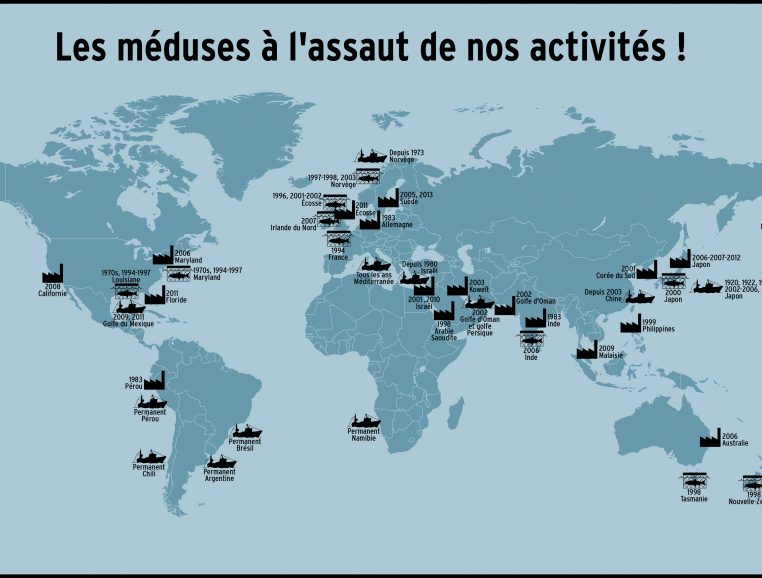
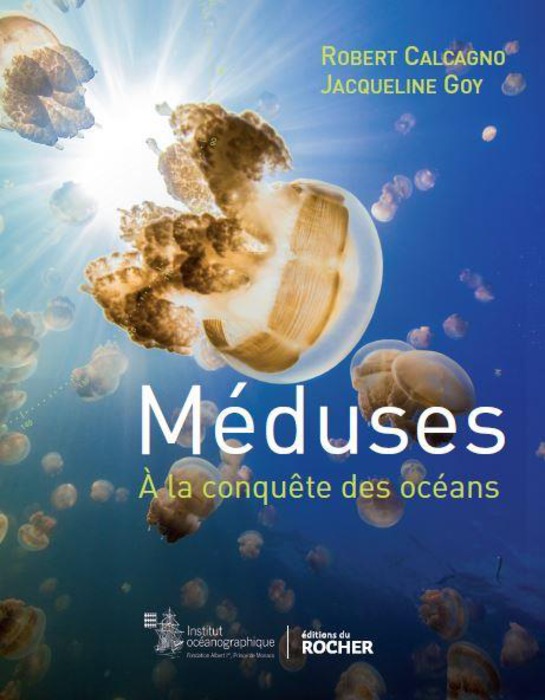
Learning about jellyfish at the Oceanographic Institute
Despite their simplicity, jellyfish can also be of some service to us and have already won two Nobel prizes. Perhaps one day they will share the secret of immortality? Science is going after their secrets.
Jellyfish are thus at the heart of a comprehensive programme run by the Oceanographic Institute of Monaco. The aquariums of the Oceanographic Museum offer a real encounter with jellyfish (aurelias, cassiopaea…).
In addition, conferences and temporary exhibitions were organized in 2014 on the theme
“The new lords of the oceans: sharks or jellyfish?”
In addition, conferences and temporary exhibitions were organized in 2014 on the theme of “The new lords of the oceans: sharks or jellyfish?”, both at the Maison des océans in Paris and at the Oceanographic Museum in Monaco.
The book “Jellyfish: conquering the oceans” is a further development of this programme. It is published by Éditions du Rocher and is available for 19,90€.
See also
Jellyfish and man
Dreaded since antiquity, jellyfish have only been studied by scientists since the 20th century. Today, we are discovering their capacity for adaptation and regeneration. This gelatinous animal is a gold mine for medical and biochemical research, which hopes to use their particularities to heal. But jellyfish are proliferating, perhaps to the point of changing biotopes, and seem to be taking advantage of declining fish stocks. Let’s take stock with Jacqueline Goy, author of this scientific fact sheet.
Are we right to fear jellyfish?
In ancient times, the nuisance caused by jellyfish prompted Aristotle to give them the name “cnid” (Greek for “stinging”) and, as a tribute, scientists created the group of cnidarians to designate all animals with this function.
Jellyfish stings are not all of the same severity and, on our coasts, they can cause simple itching or deep ulceration. This is precisely what the sailors felt when sorting out trawl bags filled with physalies during the Prince Albert I of Monaco’s campaigns off the Azores. The physalies are not jellyfish but siphonophores whose long tentacles recover the preys by paralyzing them thanks to their toxins. Studied by two scientists, Charles Richet and Paul Portier, whom the Prince took on board, and tested on animals, the toxin had an effect on the heart and lungs, more violent on second contact. Both scholars called this reaction anaphylaxis, the opposite of phylaxis or protection. This is the height of allergies. Charles Richet was awarded the Nobel Prize in Medicine and Physiology in 1913.
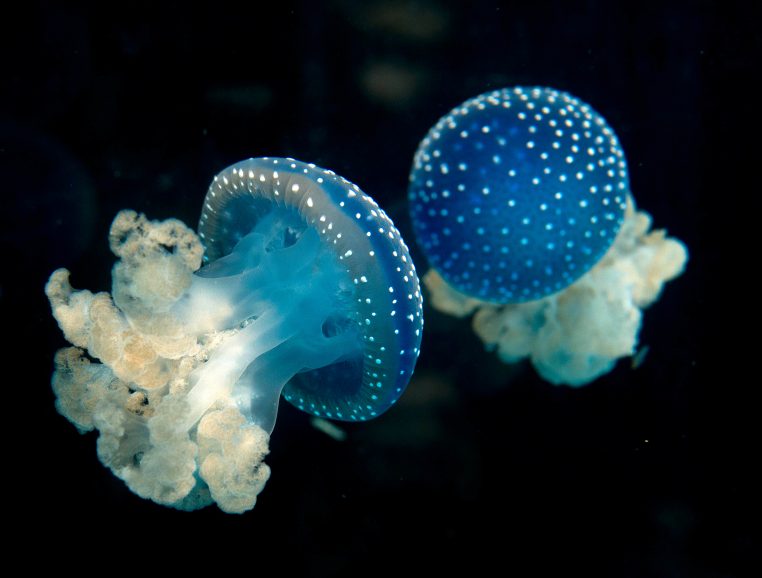
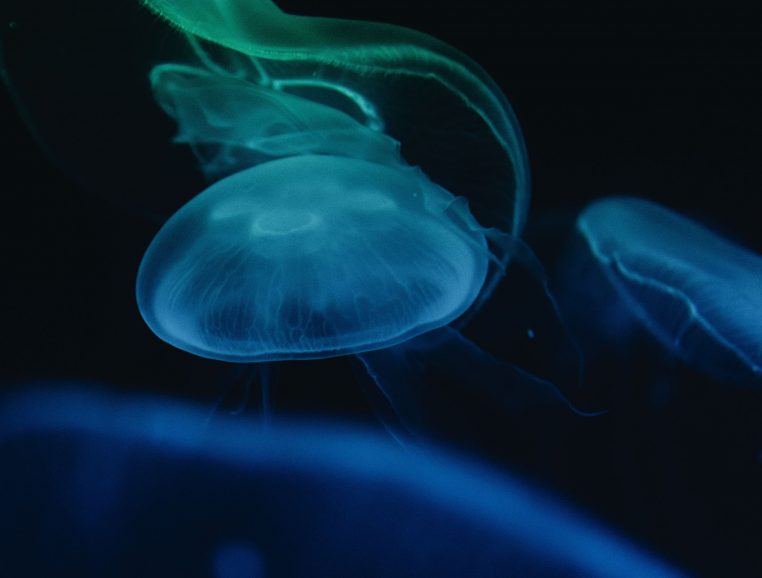
Will we end up eating jellyfish instead of fish?
Overfishing leaves food available that is not consumed by fish, and jellyfish take advantage of this, which encourages their growth. The increase in water temperature can accelerate the reproduction of jellyfish, and the young are not likely to suffer from starvation in this favourable trophic environment. This general gelling of the oceans due to human activity is a dangerous deviation for the economy of the seas because jellyfish are not very valuable as food. Eating them – drinking them would be more accurate because of the 96% water content – does not constitute an energy meal.
Not so different from humans?
Jellyfish have eyes distributed along the edge of the umbrella: simple pigmented spots or with a cornea, a lens and a retina with a bipolar pigment layer. This is the first outline of cephalization, the study of which gives interesting perspectives for healing in cases of retinal degeneration. Another surprise after the mad cow disease which directed the research of collagen towards other animals than bovines, is the discovery of a collagen of human type in jellyfish. It is used as a fake skin for burn victims, as a culture medium in cytology and is an effective anti-wrinkle in cosmetology.
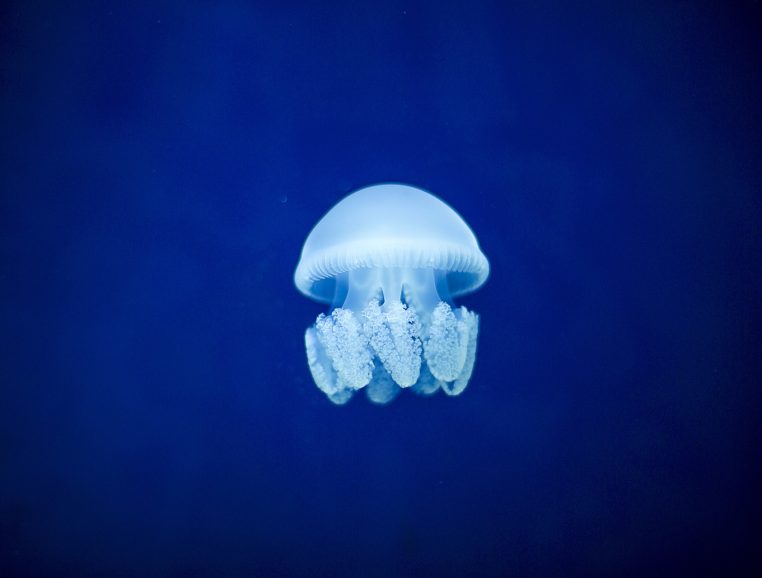
See also
The big family of jellyfish
Not everything that is gelatinous is a jellyfish!
In English, the term jellyfish most often describes the whole of the gelatinous plankton which includes, in addition to jellyfish, other animals such as siphonophores (physalies…), thaliaceans (salps, pyrosomes…) and ctenophores (sea gooseberries, beroes…). As far as jellyfish are concerned, there are four main groups according to their life cycle.
Is classifying jellyfish an impossible task?
Their size varies from a few millimetres to two metres in diameter, their tentacles can be non-existent or numerous and measure several tens of metres.
Their shapes are varied: round, square, flat, domed, massive… Their edges can be smooth or lobed.
Depending on the species, the oral arms may be smooth, scalloped or cauliflower-like.
Scyphomedus has generally a free life stage and a fixed life stage. There are 190 known species, including Pelagia noctiluca and Aurelia aurita.
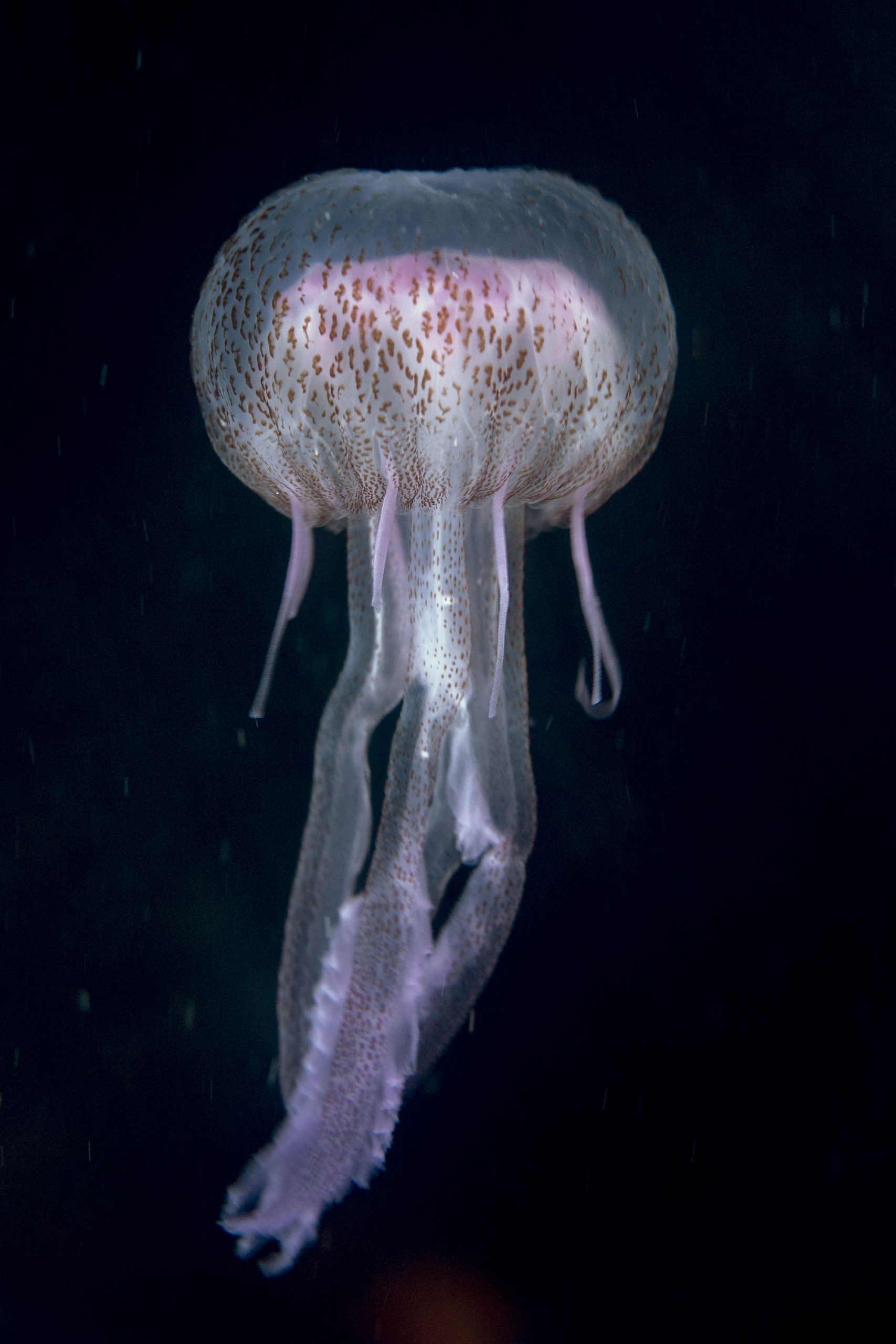

What are the differences between the four groups?
There are 840 species of Hydromedus, of which only 20% have a known life cycle.
They have a fixed stage called polyp and a free stage called jellyfish, such as equorae and velella.
Concentrations of velella(Velella velella), also known as St. John’s barks, are often observed in June at the time of the summer solstice.
After a storm, they can be found stranded by the thousands along the beaches.
Provided you are not allergic, the vellum is not dangerous for humans.
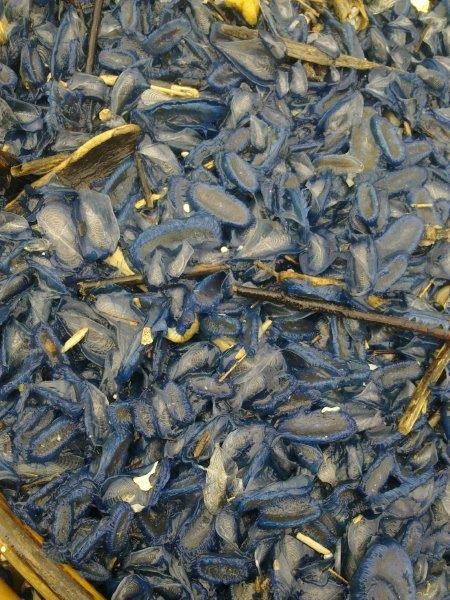
Rare and enigmatic jellyfish
With their cubic umbrella, they are the most dangerous of all.
Of the 40 or so species, only 10% have a known life cycle.
Among the cubomedus, the famous Chironex fleckeri, known as the “sea sting”, “sea wasp” or “hand of death”, lives in the waters of the North Australian and South-East Asian coasts.
The species Carybdea marsupialis is sometimes found in summer in the warm temperate waters of the North Atlantic Ocean and the Mediterranean.
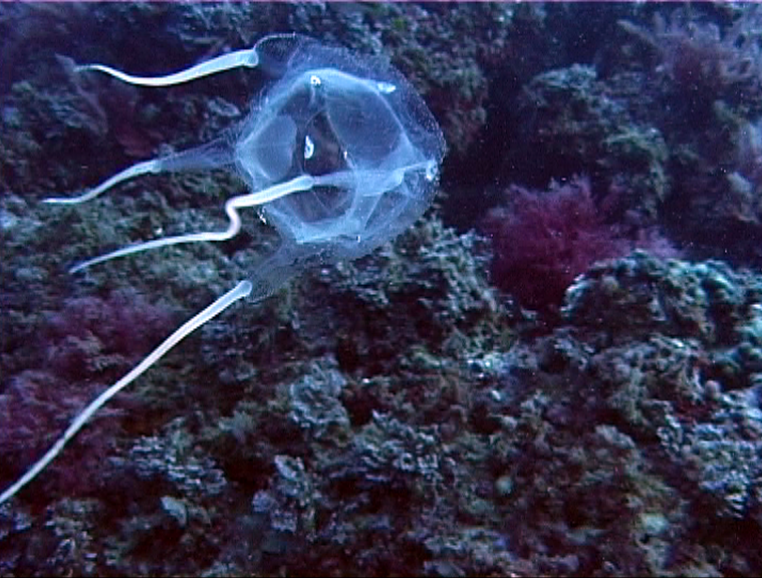
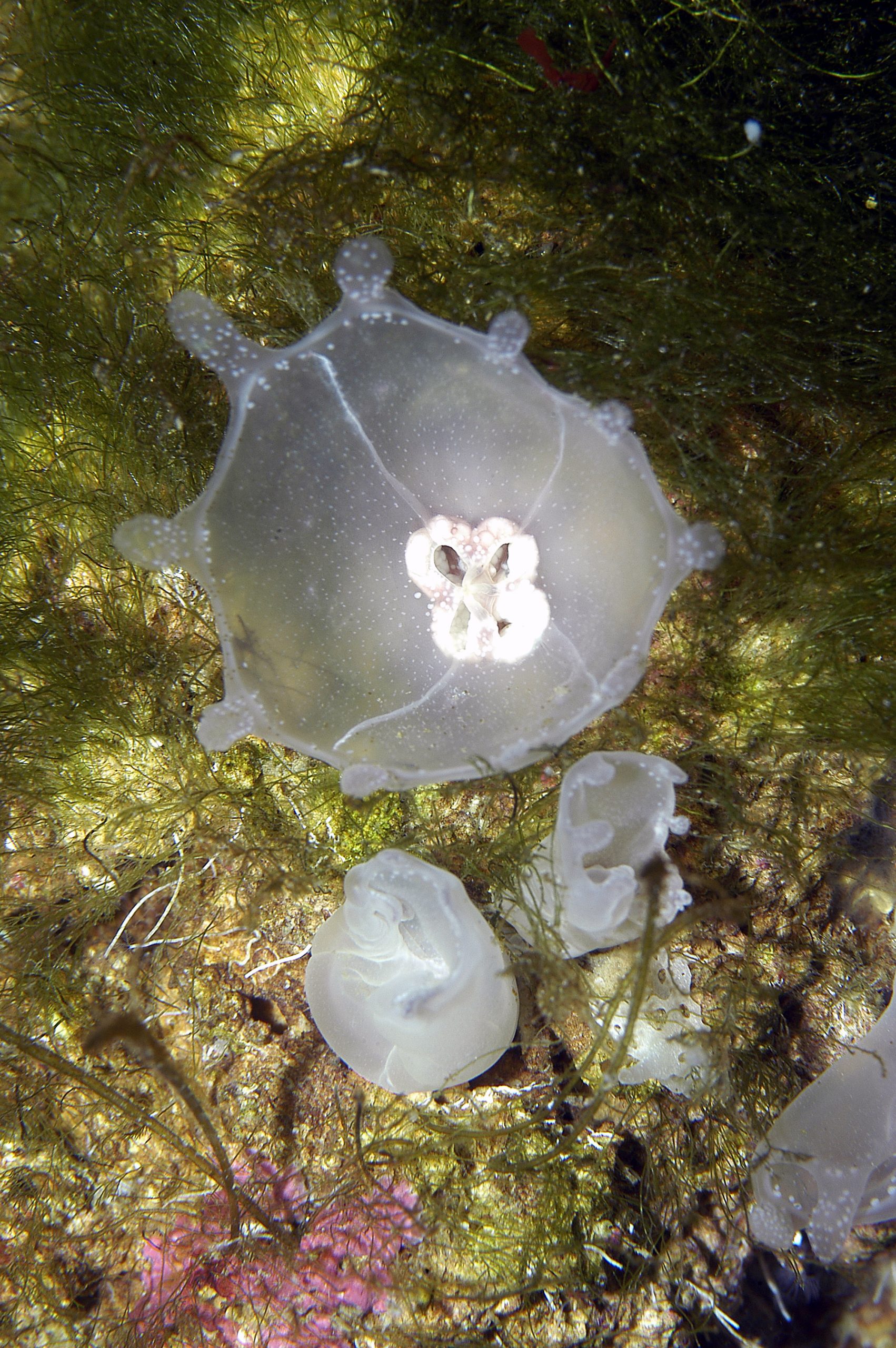
RARE AND ENIGMATIC JELLYFISH, THE STAUROMEDUS
The fourth very special group consists of about twenty species that live attached to the ground or to a wall, and do not have a free stage.
A rare stauromedusa, Lipkea ruspoliana, was identified in 1998, in the aquariums of the Oceanographic Museum of Monaco. It had never been found in the Mediterranean since it was first described in 1886 by Carl Vogt, from a specimen fished off the northwest coast of Sardinia. The Japanese specialist Tohru Uchida considers it to be the ancestral form of all Cnidarians!
In terms of evolution, Lipkea is to jellyfish what the coelacanth fish is to vertebrates.
See also
Getting involved to save sharks
2013, the Sharks program of the Oceanographic Institute
Awareness-raising operations, dedicated exhibitions at the Oceanographic Museum, events for all, international scientific meetings: shark conservation is a major issue for the Oceanographic Institute. Through its major action programme “Sharks”, initiated in 2013, the Institute invites you to meet these lords of the seas, as fascinating as they are unknown, and advocates for a balanced management of the cohabitation issue that we face…
Sharks, which are essential for balance in the oceans, are under threat
Sharks are the keystone of marine ecosystems, ensuring their balance and vitality. If sharks were to become extinct or scarce, ecosystems would be disrupted, with a cascade of threats to many other species. After 400 million years of dominating the oceans, shark populations have declined by 80-99% in the last 50 years. To avoid this catastrophe, the Oceanographic Institute is seeking to promote peaceful cohabitation between humans and sharks, even in the rare cases where sharks pose a risk to humans.
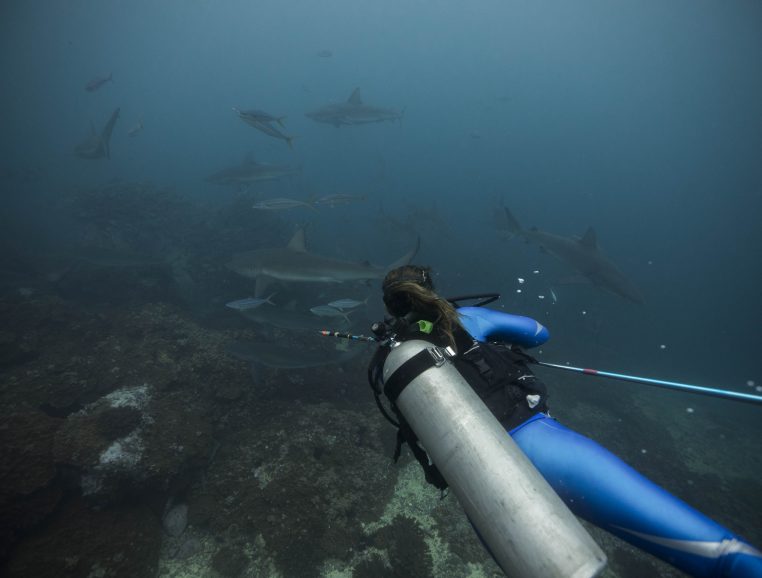
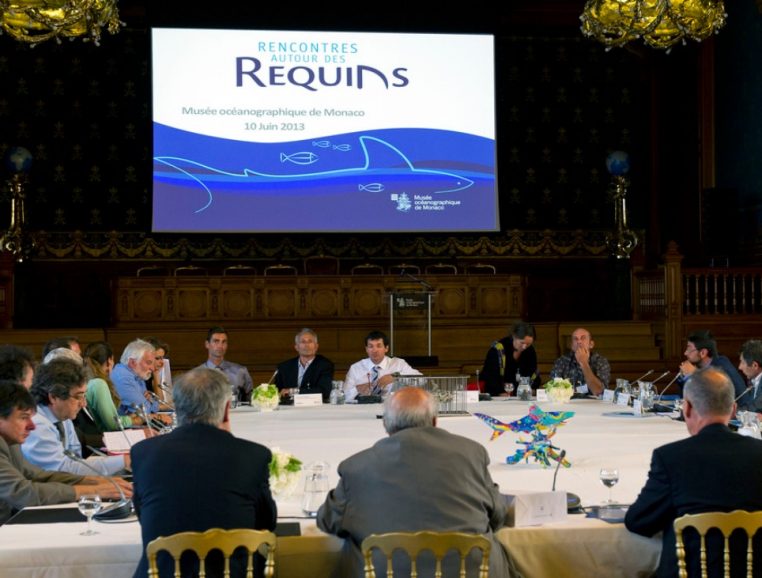
Discussion workshops for protecting sharks
Together with its partners, the Oceanographic Institute regularly organizes high-level workshops. This was the case, for example, in 2013 during the two exchanges between international experts on the cohabitation between humans and sharks. These exchanges allow us to progress in the knowledge and protection of sharks and human activities, especially when there is a risk of accident: these meetings have led to the creation of a single document to date: the “shark risk toolbox”.
What is the “Monaco Blue Initiative”?
Launched in 2010 by H.S.H. Prince Albert II of Monaco, the Monaco Blue Initiative is a discussion platform co-organised by the Oceanographic Institute – Albert I, Prince of Monaco Foundation and the Prince Albert II of Monaco Foundation. It brings its members together once a year to address current and future global challenges in ocean management and conservation. This event provides a stimulating environment to encourage exchanges between companies, scientists and decision-makers, to analyse and promote possible synergies between the protection of the marine environment and socio-economic development.

See also
Men or sharks: who have the biggest jaws in the sea?
Symbol of a wild and rebellious nature, the shark represents the limit of our domination of the seas, a frontier that some people are determined to push back to the abyss. In this 2013 op-ed, Robert Calcagno questions the relationship between humans and sharks.
Opinion column by Robert Calcagno, Director General of the Oceanographic Institute, Fondation Albert I, Prince of Monacopublished in the Huffington Post on January 22, 2013.
A matter of reputation
In our Western culture, sharks have always been given the most detestable labels. They have the unenviable status of scapegoats and have been blamed for all the difficulties encountered by man in his conquest of the marine environment. Legend has it that they devoured shipwrecked sailors when the first boats headed out to sea, ate airplane pilots when the first paddleboats were found at sea, and were even disloyal competitors of fishermen when the catch proved insufficient.
No accusation was spared them, not even that of manhunters. Since the film “Jaws” (1975), it seems to be accepted that sharks have been stalking swimmers, surfers and windsurfers right up to the edge of the beach. When an accident occurs, it doesn’t take much for the man, in an outpouring of hatred, to demand justice.
What marine animal today can claim to match the media coverage of the shark or enjoy such a loathsome reputation? At no time, however, does the man question himself. He never establishes a correlation between the increase in the number of attacks and the boom in boating activities, which considerably increases the probability of an encounter between man and beast. For of the two, which is the one who invades the other’s territory?

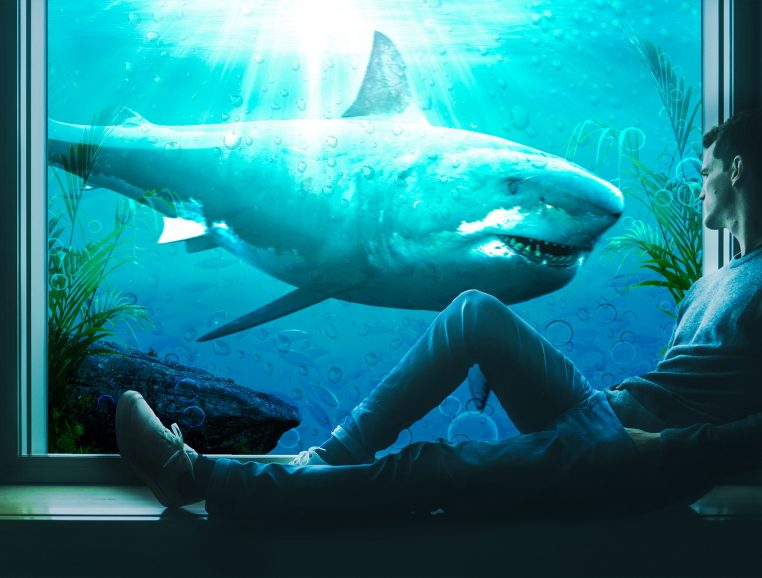
The danger is elsewhere
Symbol of a rebellious nature, the shark represents the limit of our domination of the seas, a frontier that some people are determined to push back to the abyss. While the oceans are today appreciated as one of the last spaces of freedom, claimed by water sports and underwater enthusiasts, man seeks to introduce control and mastery. What sense would there be in a freedom that is exercised in a polite and sanitized world?
To focus on the domination of nature in this way is to ignore the origin of the danger, for it comes much more from within those lands that we think we control. While sharks kill less than a dozen people a year worldwide, collapsing sand tunnels in the United States alone cause that many deaths. In France, nearly 500 people die every summer from accidental drowning, including more than 50 in swimming pools. Not to mention the incomparably higher risk of accidents on the beach road! How would the total eradication of sharks have a positive effect on these statistics?
Since their appearance nearly 400 million years ago, sharks have escaped all extinction crises, surviving, for example, the dinosaurs. Today, however, man is making a rare effort to make them disappear. Specifically fished, most often for their fins, or caught in the great trap of global overfishing, more than 50 million of them disappear each year. Most known shark stocks have declined by 80-99% since industrial fishing began in the mid-20th century. With no qualms about it, or even with the satisfaction of getting rid of competitors or annoyances, man is reducing the oceans to vast pools.
Accepting a wild sea
Some island cultures could have enlightened us. Nurturing a completely different relationship with the sea, they respect sharks as the embodiment of a nature that gives and receives, that feeds and kills, without any malice and sometimes even with foresight, weighing souls to select victims and miracles.
The West, for its part, preferred to break the harmony and opt for confrontation. We are not aware that sharks play a key role in maintaining the balance and vitality of marine ecosystems by controlling the lower levels of the food pyramid and selecting weakened prey. Locally, the disappearance of sharks has already led to significant upheavals: an increase in the number of rays, which have wiped out the century-old scallop beds on the northeast coast of the United States, and the development of octopuses, which have feasted on New Zealand lobsters. On a large scale, the intensive traffic in these animals is leading us headlong into the unknown. We are certainly moving towards absolute domination, but domination over impoverished and barren oceans.
Our indiscriminate fight against the sharks is a testament to the poor life lessons learned so far. By wishing to push back the limits of the natural environment and the last great wild animals, we refuse any cohabitation which would not be based on domination. Accepting nature means accepting that some spaces escape our rules and requirements. Beyond questioning ourselves about the oceans, let’s question ourselves about the people we want to be…
Is it not urgent to show altruism by demonstrating that our freedom can also stop in front of that of other species which, good or bad, useful or useless, have for first characteristic to share our blue planet? It is at the price of this change of philosophical posture that humanity will be able to find balance and serenity.

See also
The seven species of sea turtles in the world
Out of more than 300 species of turtles, only 7 live in the sea
There are more than 300 species of turtles in the world, of which 250 are aquatic (living in freshwater, wetlands and marshes), 60 terrestrial and only 7 marine, as Flegra Bentivegna explains in the following fact sheet.
Six species in a single family: the Cheloniidae
Of the seven species of sea turtles, six belong to the family Cheloniidae. This family has the characteristic of having a carapace without a hull covered with scales and one or two claws on the fins. Only the leatherback turtle is part of the Dermochelyidae family, characterized by the absence of horns and scales on its carapace.
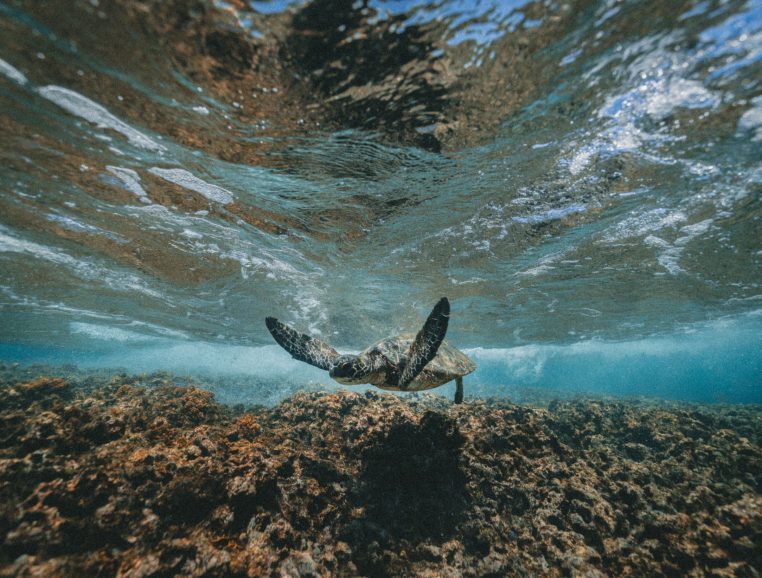
Very distinct characteristics
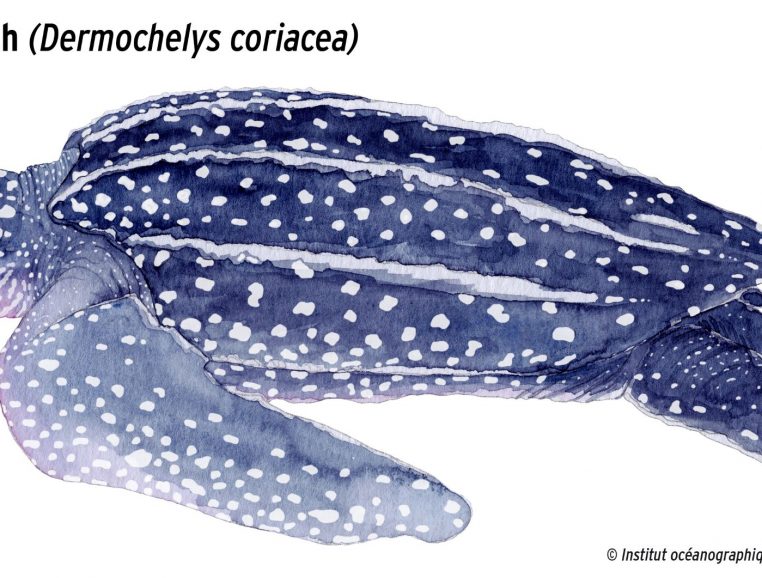
The leatherback - the most massive of turtles
Dermochelys coriacea is the only species in the family Dermochelyidae. It is the most imposing of the marine turtles. It can reach 400 kg and exceed two meters in length. Its carapace is not covered with scales but with a tough skin.
The green turtle - plant-coloured
Chelonia mydas is the largest of the cheloniids. Its weight varies from 160 to 250 kg and its height from 80 to 130 cm. In the juvenile stage, the green turtle is essentially carnivorous and feeds on small crustaceans and fish.
As an adult, it becomes vegetarian and feeds mainly on marine plants. It owes its name to the unusual colour of its flesh, attributable to its diet.
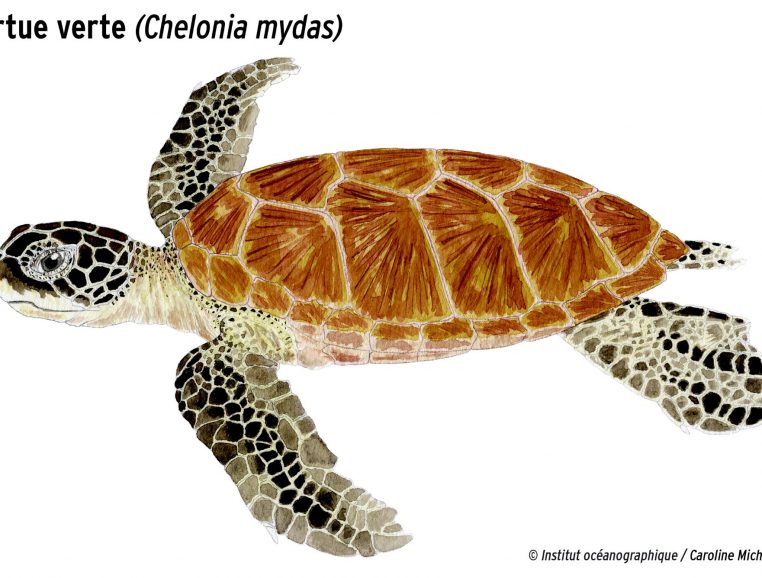
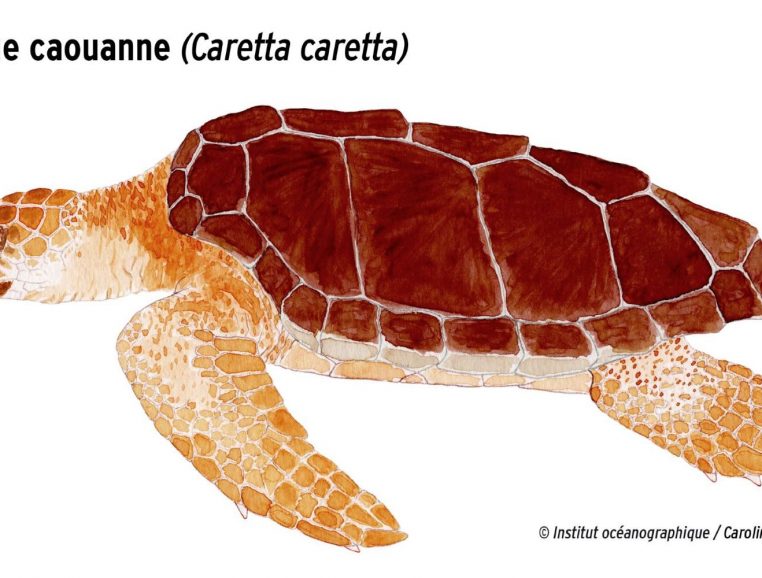
The loggerhead turtle - a carnivore’s effective jaws
Caretta caretta measures up to 120 cm for 200 kg. Carnivorous, it eats jellyfish, small fish, crabs and shrimps. A powerful jaw muscle allows it to crush the crustaceans before ingesting them.
The hawksbill turtle - a prized beauty
Eretmochelys imbricata weighs from 60 to 90 kg for a size of 60 to 120 cm. Omnivorous, it feeds on sponges making its skin toxic for humans. This characteristic has allowed him to stay away from poachers interested in meat. However, it is hunted for its beautiful scales that are easy to make into crafts such as combs or jewelry.
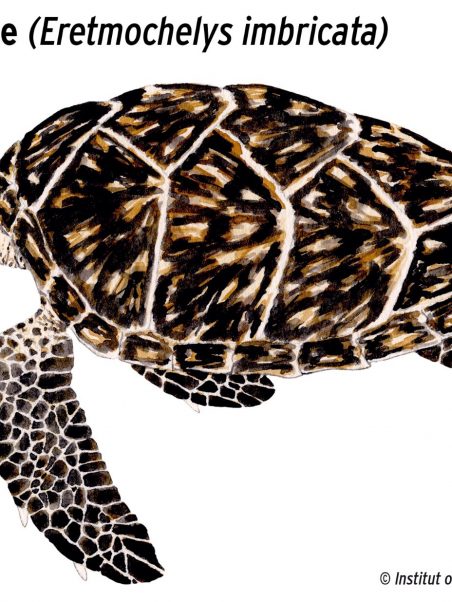
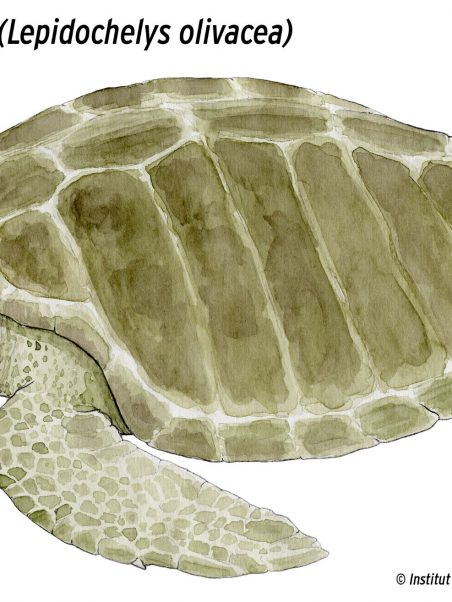
The olive ridley turtle - ready for landing
Lepidochelys olivacea owes its name to the olive-green colour of its carapace. It measures from 50 to 75 cm for a weight of 40 to 50 kg. It is known for its massive landings (called “arribadas”, in Spanish) of females coming to lay eggs on beaches of the Pacific coasts of Central America (Mexico, Costa Rica, Panama), as well as in South America, on the coasts of Surinam.
Kemp's ridley turtle - the shy one
Lepidochelys kempii is the rarest and most discreet. It is also the smallest: from 45 to 70 cm for 30 to 50 kg. It lays mainly on the Mexican beach of Playa de Rancho Nuevo.
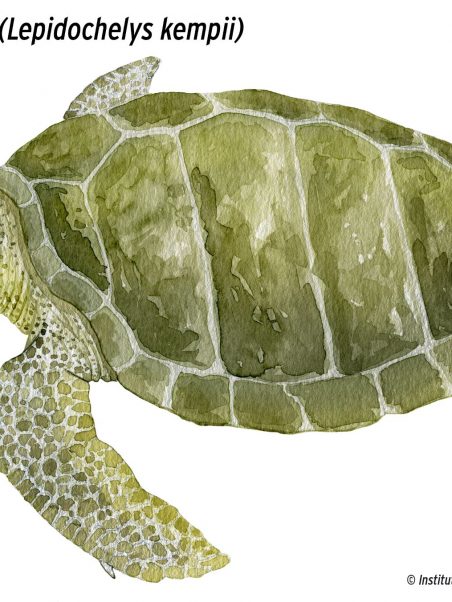
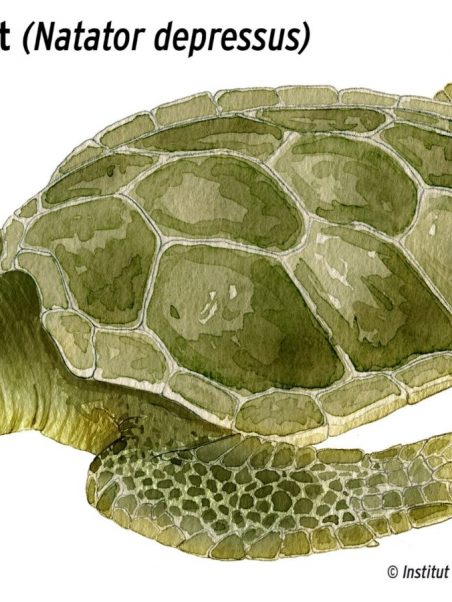
The Australian flatback sea turtle
Natator depressus is found exclusively between Australia, Papua New Guinea and Indonesia. To date, only a few beaches in northern Australia seem to be home to them for breeding. Its name comes from its particularly flat shell. It measures from 95 to 130 cm for a weight of 100 to 150 kg. Its diet of sea cucumbers, shellfish and jellyfish makes it a carnivorous turtle.
The disputed existence of an eight species
Some specialists speak of eight species of turtles. This subject remains controversial: Chelonia agassizii is sometimes considered as a subspecies of the green turtle Chelonia mydas.
Whether there is one more species or not, the current threats to marine biodiversity encourage us to marvel at these “seven sea turtles of the world” and protect them.
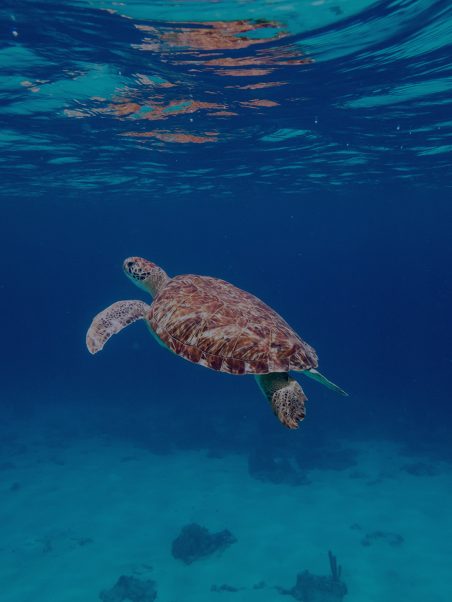
See also
S.O.S. Turtles
A game to raise awareness about the protection of marine turtles
In 2017, the Oceanographic Institute and the Prince Albert I Foundation joined forces with the Monaco company Éléments Éditions and released an ecologically designed board game, S.O.S. Turtles, to enable families to understand the challenges of protecting sea turtles from the dangers of human activities.

Learn as a family to act for the environment
Each player chooses a species of sea turtle. His mission will be to protect it from the wind so that it can reproduce.
The player who has protected the most individuals of his species wins the game.
However, there is no competition, the players help each other in all dangers: overfishing, destruction of beaches, involuntary fishing…
This simple board game can be played by two to six players. The duration of a game is about 30 minutes.
An ecologically designed board game
To remain consistent with the ambition of the game, its creators (Cédric Duwelz and Éléments Éditions) have observed all the rules of eco-design: wooden dice, paper from sustainably managed forests and a fabric bag.
None of the parts are made of plastic in order to better respect the environment. All the illustrations are original and were made by Olivier Fagnère.
After a crowdfunding campaign at the end of 2016 on the Ulule platform, the game is now published for the general public and offered at a price of €29.90.
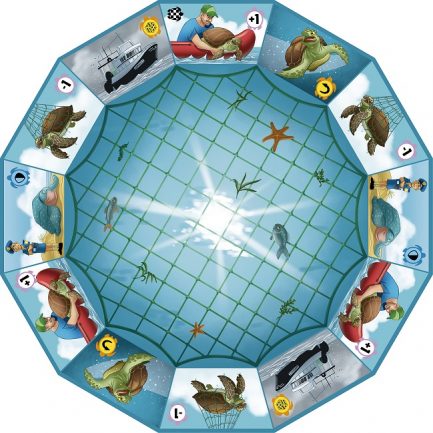
See also
Partnership with French Polynesia to protect sea turtles
Permanent relations with French Polynesia
On 8 October 2015, H.S.H. Prince Albert II of Monaco was welcomed by Mr Edouard Fritch, President of French Polynesia, to discuss ocean preservation. During this meeting, H.S.H. Prince Albert II, Mr Robert Calcagno, Director General of the Oceanographic Institute, Albert I Prince of Monaco Foundation and H.E. Mr Bernard Fautrier, Vice-President of the Prince Albert II Foundation signed a partnership agreement with the association Te mana o te moana(the spirit of the ocean), chaired by Dr. M. M. M., is the first of its kind in the world. Cécile Gaspar to strengthen the protection of marine turtles in Polynesia.

The work of the Te mana o te moana association
The association Te mana o te moana is very involved in the protection of sea turtles.
Since 2005, it has been managing a sea turtle care centre in Moorea and, since 2011, the French Polynesian sea turtle observatory.
As large as Europe, French Polynesia and its territorial waters play an essential role for regional biodiversity and Pacific Ocean turtles such as green and hawksbill turtles.
See also
“Tortues marines, la Grande Odyssée”
Marine turtles, the great odyssey: a reference book
Robert Calcagno, director of the Oceanographic Institute of Monaco, signs his tenth book on the theme of oceanography: Tortues marines, la grande odyssée, published by Glénat in 2017. Highly documented, it deals with the evolution of marine turtle populations from their appearance to the present day, drawing the reader’s attention to the environmental changes that threaten their survival today.
The mysterious odyssey of an endangered species
Robert Calcagno, affirms it: “It took only half a century for man to threaten the existence of sea turtles! Symbols of wisdom and longevity, sometimes immortality, sea turtles have fascinated many civilizations.
All seven species of marine turtles are vulnerable or threatened because they are subject to most of the pressures that humans exert on the marine environment. Sea turtles could become extinct due to current environmental changes.
Having appeared 110 million years ago, these great migratory birds still hold many mysteries. To better understand their life cycle, it is necessary to study them while preserving their habitats. To safeguard them, protection solutions at an international level must be considered.
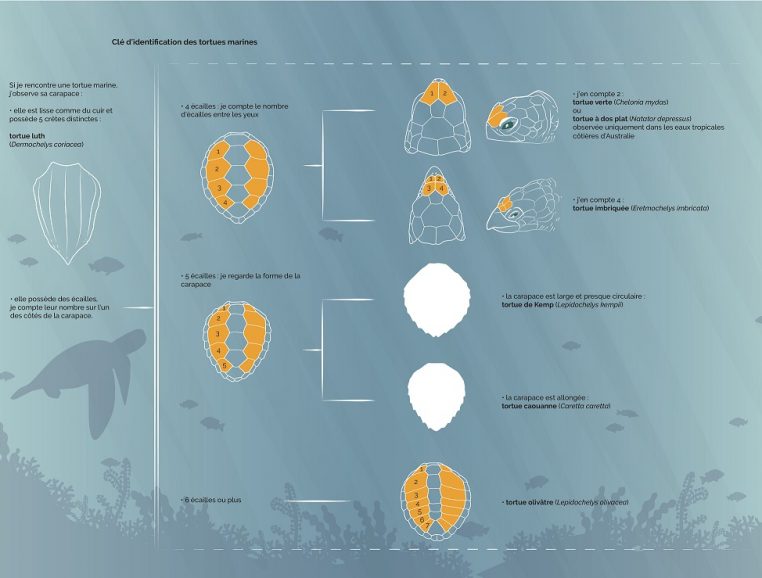
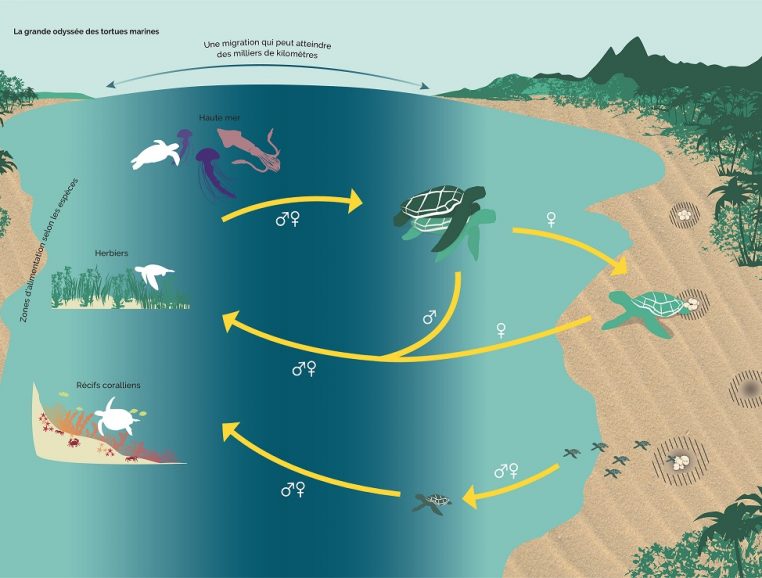
A life of travel
At the crossroads of the worlds of water and land, marine turtles are among the animals that still retain a great deal of mystery.
Migrations, mating rituals, mechanisms triggering egg-laying… we still don’t know a lot.
Thanks to the latest technology, scientific research is working to unravel the mysteries that still surround turtles to address the urgent need to ensure their future.
Turtles confronted with our appetite
Sea turtle fishing is still allowed in the territorial waters of 42 countries and 42,000 turtles are still caught legally each year.
The consumption of their meat and eggs and the use of their shells are the main reasons for the decline in their populations.
The various protection measures taken in recent decades remain poorly implemented. The plight of the turtles began with overexploitation but is intensifying with man’s hold on the ocean and coastline.
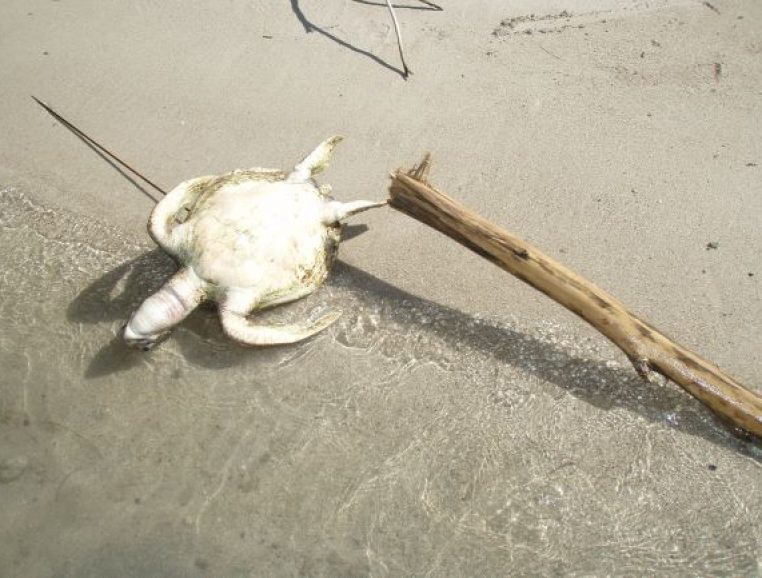
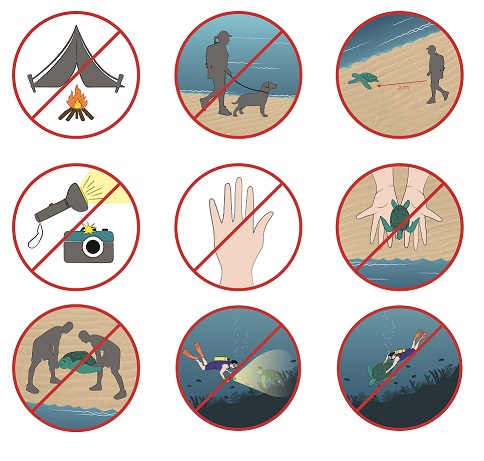
Cohabiting with turtles
If we want to save sea turtles, we need to protect them better.
At a time when holidaymakers from all over the world are flocking to the fine sandy beaches, a small part of this Eden must be reserved for the turtles.
This is quite a challenge in view of the fact that the development of tourism on these coasts is seen as an essential lever for economic development.







